Estella - Falling In Love Again
Sunday, May 31, 2009
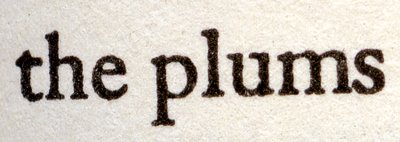
Coincidentally on Saturday I read two essays on books. On the editorial page of the NY Times there was Verlyn Klinkenborg’s Some Thoughts on the Pleasures of Being a Re-Reader and in the Vancouver Sun convergence editor Rick Ouston (never one for smiling on cue) wrote how a condo leak precipitated him into getting rid of most of his books in Bookshelf clearout, a heresy brought by condo repairs.
With the exception of “reference books survived the cut, along with a few favourite novels, books by friends, my own scribblings and some borrowed screeds that I must really return to their owners…” Ouston stated, “…at the end, I felt a sense of relief, like a glass of cold water on a hot day.”
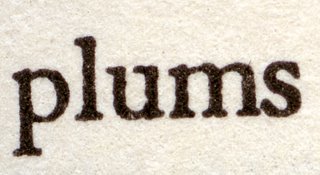
If anything Ouston’s essay makes my eventual (soon, I would say ) decision on what to do with all the books I have acquired since I began buying them, even more poingnant, terryfing, stressful, and finally so depressing. How does one get rid of books? In Ouston’s case the leaks on his walls pushed the decision forward. In my case as Rosemary and I look at the eventual selling of the house I understand that there will be simply no room for all the books and the multiple antique bookcases of our present home.
Fortunately the sadness precipitated by Ouston’s screed and further magnified by gazing on his taciturn and almost melancholy face in the photograph that accompanied the article, was ameliorated a touch by the far happier tone of Klinkengborg’s musings on re-reading books. He asserts:
The real secret of re-reading is simply this: It is impossible. The characters remain the same, and the words never change, but the reader always does. Pip is always there to be revisited, but you the reader, are a little like the convict who surprises him in the graveyard – always a stranger.
I had to smile when I read this as both Klinkenborg and I often re-read Great Expectations.
I re-read often and I have a few favourites. Two are Daphne Du Maurier’s. The House on the Strand after repeated re-readings has yet to reveal to me the mysteries of its ending. The other, The Scapegoat I will perhaps not re-read further. I was finally able to see the film version with Alec Guinness and Bette Davis.

There are two science fiction books that surprise me every time I reprise them. One is Arthur C Clarke’s Rendezvous with Rama and the other is Walter M. Miller Jr’s A Canticle for Leibovitz .
In “literature” I often re-read Mario Vargas Llosa’s The War of the End of The World and at least once a year I revisit Graham Greene’s The Power and the Glory. I am a sucker for any of Jerome Charyn's Isaac Sidels but Blue Eyes is my fave.
I have finished P.C Wren’s Beau Geste at least three times sometime in the middle of the night and nautical novels are a particular passion. I have read both C.S. Forrester’s Hornblower novels and Patrick O’Brian’s Jack Aubrey and Stephen Maturin series twice. In particular O’Brian’s first of the series Master and Commander . That first meeting between the men at a concert that almost ends in a duel is sheer fun every time.
As I re-read I have come to understand that some of my novels may need to rest for a longer time period between readings. Perhaps in the next few months I will tackle Umberto Eco’s Focault’s Pendulum and Charles Palliser’s Quincunx.
Poetry has not been on my favourites list ever but there is one summer ritual I do not fail at. I read William Carlos Williams' Selected Poems . I am delighted that Rebecca agrees on me on this one. She has memorized the poem about the plums in the icebox.
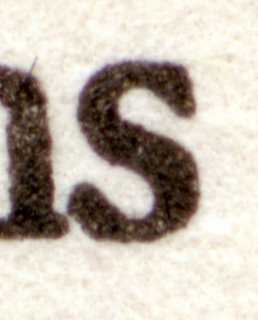
No matter how I look at it, I know that the moment I may get rid of a book I would need it for reference purposes soon after and I would miss it by not having it.
Getting rid of my books would be like obliterating my memory and the living I have lived through them. There is always that thrill of falling in love, through Pip, with the icy Estella. Re-reading Great Expectations is like falling in love for the first time, every time.
Alex Summers Revisited
Saturday, May 30, 2009

In 1967 Alex Summers was turning the crank of a mimeograph machine inside the little office of the American Penstemon Society. He had been lured by some friends for the job. It ocurred to him that he did not like penstemons nor was he interested in publishing a journal on them. So he founded the American Hosta Society in the next year. He has not looked back. The AHS is one of the healthiest of the American plant organizations and their journal, The Hosta Journal, is a glossy publication, thick and full of useful information and illustrated with full colour photographs of hostas at their peak. The once a year national conventions are attended by hosta enthusiasts from all over the world. In the 1992 convention in Columbus, Ohio I met Alex for the first time. It took me a while to figure out that his trademark mumble camouflaged intelligence, erudition and garden knowledge second to none. He took me under his wing and gave me advice that I have never forgotten and always apply. He said:
"A garden must have three important elements. They are elevation, shade and water. And you must make sure you can hear it."
"It takes a year to plan and design a garden. You need a year to build it. You wait three years for it to mature. On the 6th year you enjoy it. In the seventh it declines. You start from scratch on the 8th." I photographed Alex in his farm in Bridgeville, Delaware. At the time his charming wife, Gene was alive. Alex here poses with a leaf of Hosta 'Aurora Borealis'. He insisted that Hosta 'Frances Williams' was this one and no other.
American Hosta Society
I wrote the above here back in the first year of my blogs. A few weeks ago I received a communication from the art director of the American Hosta Society Journal that Alex Summers had died and that they wanted to use the picture you see here (a b+w version) on the cover. Of course I felt honoured while feeling sad for the loss of a friend. The last time I saw him in Washington DC his trademark mumbling was at its worst and nobody seemed to want to sit next to him on the bus tours of the DC hosta gardens. Rebecca innocently sat next to him and somehow they got along just fine. Since this happened five years ago Rebecca's memory of Alex Summers is beginning to fade. But I know that someday with a bit of reinforcement she will remember and know that she met a great garden man. It was only today that I pointed at a beautiful hosta in my garden and Rebecca said, "That's Hosta 'Alex Summers'.
The art director of the Hosta Journal chose the picture because, "Can you imagine? Alex is wearing an unbuttoned shirt!" We all knew he was a sexy man.
Rebecca Returns Thanks To The Rose
Friday, May 29, 2009

I think I obtained my first rose bush sometime in 1987 and I am sure it and a few more I bought subsequently died. I didn't give them enough sun and I did no have a clue how to prune or take care of them. Even today I am a tad unsure. I think I could explain most of the types of roses and their origins but that has taken all these years for me to learn. Roses, no matter how often you might be told to the contrary are complex plants. This may explain why my friends of the Vancouver Rose Society are having a World Rose Convention at the Bayshore Hotel and a Rose Festival at the new Vancouver Convention Centre. The dates for the convention are different, too! The convention will be from June 18 to the 24th and the festival from June 19 to the 21st.
But for me there is something good among all the confusion. At the Vancouver Convention Centre I will be one of a few who will be giving lecture/demonstrations for the general public on those three days, June 19, 20 and 21. I have spoken to garden clubs many times through the years about hostas, roses and how to photograph them. But what is special is that my topic is A Rose Through a Child's Eyes. I will be co-lecturing with my granddaughter Rebecca (11) who of late has gone bonkers over roses and in particular over the deep red ones like William Shakespeare, Falstaff, Charles de Mills and her very own favourite (I don't have it. I bought it for her some years ago) Tuscany Superb. Rebecca has informed me that she has no problem talking about roses to any group of people who might attend our talk. I will project my rose scans (the two here are Rosa 'Blanc Double de Coubert' which I cut this afternoon. The bloom had not quite opened yet.) and pictures of Rebecca and Lauren with roses. I will demonstrate with lights how I photograph my granddaughters by rose bushes or with roses.
I had thought that I had a very close relationship with my Rebecca since we started doing things together from an early age. We have traveled with Rosemary to Argentina, Uruguay, Texas, Washington DC and to Mexico three times. We have gone to dance, theatre, opera and baroque concerts. Then a couple of years ago she declared her independence and decided to become a teenager before she was 10. I was despondent and my friend Abraham Rogatnick told me to be patient and that she would come back. I had not expected this to happen so soon nor would I have suspected that the catalyst would be the rose.
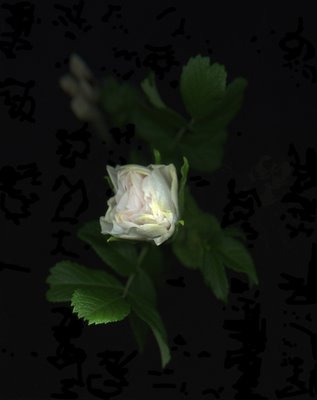
Tomorrow after Rebecca's piano class we will label all the roses in the back garden (we did the front garden a couple of weeks ago). In her neat writing she will write the names of the new roses on the metal labels that we place next to each rose. She will write in a notebook the condition of each bush, the colour of the rose, the type of rose it is and she will describe its scent. By the time we finish and with her good memory Rebecca will have full knowledge of my 75 plus roses. As it is she knows more about roses, how to grow them and how to take care of them than I did back in 1987 when I killed my first rose! I look forward, with a great measure of pride, to sharing the floor with Rebecca in the forthcoming Rose Festival.
The Judge, The Lawyer & Mrs. Oakley Fisher
Thursday, May 28, 2009

When I read the Vancouver Sun today about maternity shop owner Susan Hayes winning her lawsuit ($600,000 plus court expenses) against Trans Link, Canada Line Rapid Transist Inc. and InTransitBC I thought of a tall and pleasant man whose office is very small. I wrote about Susan Hayes' lawyer Cameron Ward here in December 2007. I took his portrait in his claustrophobic office in the Dominion Building. He looked less like a lawyer and more like an authentic Sam Spade waiting for a dame with a problem to suddenly walk in. I wasn't far from wrong in my guess.
That this man was able to win the lawsuit says a lot, not only of his lawyerly skills but a lot about our province's legal system where the small guy (small gal?) can sometimes beat the system and the big corporations. It is my hope that Mr. Ward does get some monetary recognition so he can splurge soon on a bigger office in his beloved Dominion Bulding.
I smiled when I read about the presiding Supreme Court Justice, Ian Pitfield. No matter what decision he would have come down with, I know it would have been carefully thought out and then read with his soothing voice and perhaps with a hint of a smile. Judge Pitfield is a happy man. He was a happy man when I photographed him as a laywer at Thorsteinsson's and he was a happy man when I photographed him in the Law Courts in March 1997 when he first became a judge.
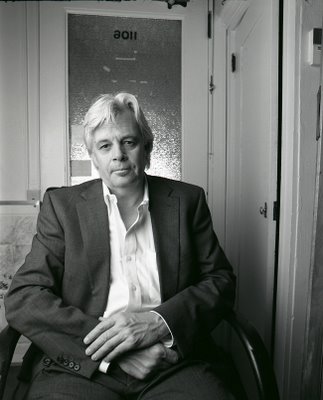
Through the years I have run into the judge a few times at Southlands Nursery. Every time he has asked me to suggest a rose he should buy. The last time I took him to a single yellow tea rose, Mrs. Oakley Fisher and told him, "This is a good rose for you. It has class and personality." I didn't add what I was thinking, "And you have class and personality in spades."
Mrs. Oakley Fisher
White Light/White Heat
Wednesday, May 27, 2009

White light, White light goin' messin' up my mind
White light, and don't you know its gonna make me go blind
White heat, aww white heat it tickle me down to my toes
White light, Ooo have mercy white light have it goodness knows
White light, White light goin' messin' up my brain
White light, Aww white light its gonna drive me insane
White heat, Aww white heat it tickle me down to my toes
White light, Aww white light I said now goodness knows, do it
Hmm hmm, White light
Aww I surely do love to watch that stuff tip itself in
Hmm hmm, White light
Watch that side, watch that side don't you know it gonna be dead in the drive
Hmm hmm, White heat
Hey foxy mama watchin' her walk down the street
Hmm hmm, White light
Come up side your head gonna make a deadend on your street
White light, White light moved in me through my brain
White light, White light goin' makin' you go insane
White heat, Aww white heat it tickle me down to my toes
White light, Aww white light I said now goodness knows
White light, Aww white light it lighten up my eyes
White light, don't you know it fills me up with suprise
White light, Aww white heat tickle me down to my toes
White light, Aww white light I tell you now goodness knows, now work it
Hmm hmm, White light
Aww she surely do moves me
Hmm hmm, White light
Watch that speed freak, watch that speed freak everybody gonna go and make it every week
Hmm hmm, White heat
Aww sputter mutter everybody gonna go kill their mother
Hmm hmm, White light
Here she comes, here she comes, everybody get 'n gone make me run to her.
In 1968 I married Rosemary Healey in Mexico City. There were student riots in Tlatelolco and many students were killed. In 1968 Mexico hosted the Summer Olympics. In 1968 my eldest daughter was born. In 1968 the Velvet Underground released an LP White Light/White Heat. I was not aware of the latter event as at the time I had no idea who Lou Reed was.
Around 1948 when I was six I was playing with a little plastic articulated toy while bathing I our Buenos Aires tub. The toy was small enough that it went down the drain before I could retrieve. I remember that I cried a lot and it seemed to be my first experience of feeling a loss. I was worried and saddened on how the little toy would manage without me.
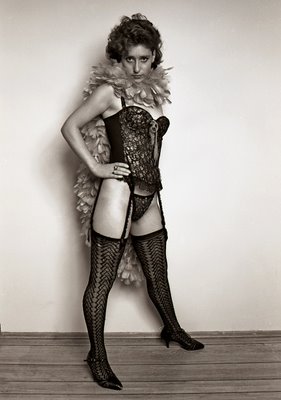
When I went to the St. Edward’s High School in Austin, Texas I 1957 I had a cheap sheet metal trunk. I kept my belongings in it. I could lock it. The first few months as a boarder were unbearable as I missed my mother and home. Brother Vincent de Paul would pass by our bunk beds in the morning and he would drop a silver Dollar. If it didn’t bounce he would tear the bed cover and sheets off and tell us to re-make the bed. I was always outraged by this. But I felt the comfort that the contents of my locked trunk were inviolate. The trunk was home.
In the late 70s I met was paired to work with writer Les Wiseman who had a rock and roll column for Vancouver Magazine called In One Ear. In short order he gave me a rock education. It was an education I had never had. He set me straight and made me a musical snob. He convinced me that Lou Reed was God and that the Velvet Underground was the church of the protopunk.
It was then that I met a lovely exotic dancer who asked me to photograph her. At the time I was pretty ignorant in that sort of photographic thing. I remember I used umbrellas. Portable soft boxes had not been invented yet. Even though this woman was important to my life in a way that Les Wiseman would understand I have forgotten her name. But I have retained her negatives and you can see some of the pictures here.
At the time Wiseman and I frquented th exotic dancer bars. He drank beer and I drank water or cokes unless (he did sometimes) he convinced that beer was the only way to understand what we were watching on stage. Beer made me rapidly sick or gave me terrible migraines. I do remember that this girl was soothing in voice, sophisticated in manners and she had the most beautiful breasts we had ever seen. We used WWII fighter pilot lingo to describe her sort of breasts in those politically uncorrect times. We called them "one o'clock highs". Fighter pilots would indicate where the bandits (enemy fighter planes attacking them) were in the sky using the clock as a model. One o'clock highs indicated planes that were high up. Her nipples pointed up to the sky.

By the late 80s I had a collection of rock T-shirts that was close to 100. They ranged from the Dead Kennedys, D.O.A. Art Bergmann, Poisoned, Young Canadians to really obscure local bands. All were in Wiseman's estimation in very good taste. The problem was the protocol of which of these shirts we would wear when going to a concert at the Commodore, the Smiling Buddha or some underground club. You would not wear a Paul Anka T-shirt to anything! An Art Bergmann T was adequate for any other Vancouver alternate scene band. Wiseman and I would laugh at the poor idiots who did not have the good sense and style that we had. We would have never ever worn a Motorhead T-shirt to a Motorhead concert!
In the end I always wore the same T-shirt. It was T that was a one-size-fits-all-occasion even though I could not possibly wear it today. It has shrunk. It is a black T-shirt that reads White Light/ White Heat. I told Wiseman, "Those who know will appreciate what I wearing and f--- those who don't know any better."
The girl with the one o'clock highs gave it to me. I cannot find it.
Addendum May 28
I found it. Such joy! Now if I could only remember her name.

James Mason & Charles de Mills Under A Loupe
Tuesday, May 26, 2009

It seems it was only just a while ago, but it really was at least three years, that Rebecca ran in from the garden with a squished fly and told me to scan it because she wanted to know what it looked like real close. The fact is that my scanner outperforms just about any high quality microscope I might have used in high school. Thanks to it and my plans scans I now look at my garden differently. I still look from my living room windows at the garden or walk near the flower beds to inspect the state of our garden. But I also get close.

I get closer and I look at the details. Unfurling ferns are beautiful. I inspect the peeling bark of some of the trees that Rosemary insisted we plant because they had that feature. Roses in bloom are beautiful to the eyes and to the nose and I believe they have no equal in the plant kingdom. But I have to point out that a rose bud that is forming (the first and second images here are of the Gallica rose, Rosa 'Charles de Mills') is just as beautiful even if it has no scent. But that is not entirely true as some of the moss roses have a pine resin scent to them before they open that is quite attractive.

The two buds shown here are quite small. The bigger one (not quite two inches long) on the left is the modern Gallica Rosa 'James Mason' and the other, again is of Charles de Mills. Do remember that if you click once and then again on each of these images they will fill your screen.
The First Of The Season - Rosa sericea pteracantha
Monday, May 25, 2009
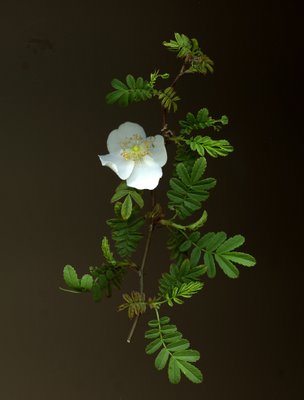
Late May is very exciting in our garden. Things happen from one day to the next. A hosta can almost double in size as it unfurls it leaves in a day. The hostas have no holes or any kind of damage. They are perfect. The lawn is as pristine as it will ever be. Some vigorous roses may grow almost a foot in height. At about this time there is a red rhododendron that begins to bloom. When it does it signals to me that if I look in the direction of Rosa ‘Blanc Double de Coubert’ there will be at least one open, pure white and extremely fragrant flower.
We arrived from Lillooet and I immediately went into the garden with Rosemary and my visiting first cousin Willoughby Blew and his wife Chris. I was disappointed to not find one single open rose. Rosa ‘Blanc Double de Coubert’ had many buds. None were open. The other rose also had a myriad of buds, but no flowers. That was the case until Chris asked me to point out the rare plants in the garden. That took us immediately to Rosa sericea pteracantha or Rosa omiensis pteracantha. The botanists cannot seem to agree on the name of this species rose which is really one species in the Rosa Subgenus Eurosa Section: Pimpinellifoliae. I signaled the oddities of this rose which has fern-like foliage and very large translucent prickles that with back light turn blood red.
I had had this rose 15 years ago but in one of those moments of botanical stupidity when I was pruning it, I somehow did not think and pruned it to the ground. No new shoots ever came up. This year Rosemary asked me to find one. I found one at Robin Dening’s Brentwood Bay Nursery on Vancouver Island. He shipped it three weeks ago and I immediately planted it.
It was Willoughby who spotted the one flower. Unique in all roses this rose has only four petals. All, single roses; with this exception have at least five petals. Later in the season as the rose matures the prickles will be in evidence. Meanwhile Rosa sericea pteracantha has beaten out ‘Blanc Double de Coubert’ for the glory of being the first rose of the season in our garden.
I could not scan Rosa sericea pteracantha last night because the flower had closed for the night. Today it opened and I have scanned it this afternoon. As I write this I can spot from my window two open Blanc Double de Coubert flowers. I will have to go and sniff them!
Juicy Sex Passages - Not
Sunday, May 24, 2009
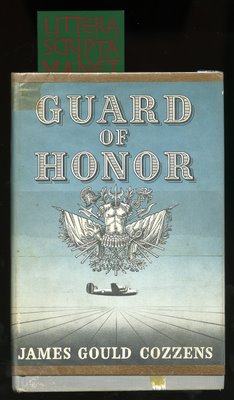
I guess it’s human nature to keep good things for oneself. It can be a little restaurant off the beaten path or a particularly hard to get rose like Rosa sericea ssp. omeiensis f. pteracantha. When people see its huge blood red translucent prickles I sometimes feel inclined to answer, “I don’t remember. I got it so long ago,” when I'm asked where I bought it. But gardeners, at least most of us, like to share our plants, or at least their provenance. I draw the line when somebody asks me if I ever split my hostas. I never split my hostas but I would like to share this book that came into my life for only fifty cents.
It was three years ago that I rummaged inside a book bin near the verboten cigarette counter of my Oakridge Safeway. I found a hard cover book that looked interesting and I paid $0.50 for it. I took it home and put it on a pile and then forgot it. About a month ago I received an e-mail from AbeBooks. Because I buy books from them I get infrequent but interesting “spam” ads. This one was about ten forgotten novels that had won the Pulitzer Prize. The only one in the list that I had ever read was Allen Drury’s Advise and Consent. All ten novels had the jacket covers shown. One looked very familiar. I ran up to my book pile and found Guard of Honor by James Gould Cozzens. My copy had been part of the King Edward Branch of the Vancouver Public Library.
The AbeBooks blurb on Cozzens was this one:
1. Guard of Honor
James Gould Cozzens
First published 1948
Highest price on AbeBooks - $850
Cozzens became immensely popular in the 1950s and was nominated for a second Pulitzer for By Love Possessed. However his popularity waned in 1957 when he was branded as an elitist after being interviewed by Time Magazine. Statements like “I can't read 10 pages of Steinbeck without throwing up,” didn’t win him any friends. Guard of Honor takes place over three days in 1943 at a Florida Airbase featuring a new hapless commander.
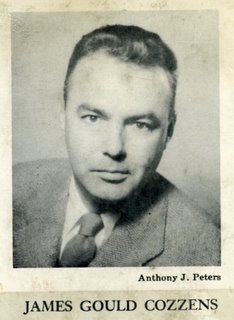
This intrigued me to try the book. It was an unexpected surprise. I savoured this remarkable book for almost a week. I didn’t want to finish it. While the book is about what happens in a Florida US Army Air Force base (the US Air Force was not yet an independent entity) one Thursday, Friday and Saturday, very little happens. It is 1943 but the war seems to be a faraway theatre. I met its commander, a flashy youngish hot shot pilot called General Beal and many more protagonists from colonels, female lieutenants and sergeants to privates. A black officer, from a soon to be all black bombing squadron and plays the literary McMuffin when a white officer punches him in the nose. The most interesting character is Captain Nathaniel Hicks who had been a magazine editor before he was drafted but was made an officer because of his experience. In the novel he works for what would now be called public affairs. Captain Hicks is an expert spin doctor. His character is based on the author himself.
During World War II, Cozzens had served in the U.S> Army Air Forces updating manuals, then in the USAAF Office of Information Services, a liaison and "information clearinghouse" between the military and the civilian press. One of the missions of his job was in controlling news, and it became Cozzens’ job to defuse situations potentially embarrassing to the Chief of the Army Air Forces, Gen. Henry H. Arnold. In the course of his job he became one of the best informed officers of any rank and service in the United States. He was made major at the end of the war. These experiences are key to the feeling of authenticity when I read Guard of Honour.
The novel is not all that easy to read. There are many characters to remember and the writing in some parts is dense. But it is all beautifully written. Consider this passage which follows General Beal’s humorous reminiscence on reasons why his wife was finally “compelled” to marry him.
In this joking relation were elements of complacence, and other elements of sentimental or self-interested reminiscence, the mind’s flat lie about the past; but also, ingeniously full-hearted, wistfully it gathered a true tenderness around the more or less distorted fact. Unmixed with anything but sadness, fond feelings could live there, secure from the minute by minute test of verifiable truth and observable fact, unspoiled by the moving instant’s irritabilities of sense, the separate discomforts, the incompatible wishes that greatly moderated, in any present, men’s appreciation of one another, let alone of their women.
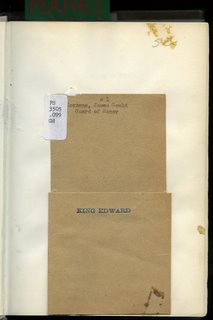
And then this is the novel’s juiciest sex passage:
“Come in here, “Nathaniel Hicks said. She was now, he realized, shaking no more that he was. She made a slight resistance. She said: “Yes. I will. I’m going to. But could you put that light out first?"
On The Road With Willoughby Blew
Saturday, May 23, 2009

Being in a car for almost four hours with my first cousin Willoughby Blew and his wife Chris was a singular pleasure. Rosemary sat in the back with Chris and Willoughby who is six foot four sat shotgun. We drove to Lillooet to visit our daughter Ale. We drove via Whistler and Pemberton and stopped on the way (near Pemberton) and we had thin, crustless cucumber sandwiches and ham sandwiches. I prepared some extra spicy deviled eggs. Rosemary brought along a large bottle of ginger ale. We listened to Daniel Berenboim's tango CD and we talked of our shared past. Chris had been dissapointed to find out we didn't have any lilacs in our garden. So it was ever so pleasant to arrive at Ale's and find three huge lilacs in bloom and their perfume wafting through her property. Ale had invited three friends, Margaret (97), Sarah and Catherine. I barbecued three pork loins. We had several salads and Willoughby noted that I put sugar into the Keen's powdered mustard mixture. "You make it like Uncle Harry used to make it, with sugar and salt." Uncle Harry was the oldest brother of my father George and Willougby's mother Lelia.
After a lengthy sobremesa (conversation at the dinner table following dinner) while drinking strong tea everybody went home and Ale took the Blews to the Reynolds Hotel.
I find it so amazing that my cousin from Buenos Aires who now lives in Florida would find himself and his wife in a relatively remote place like Ale's Lillooet. It is amazing and wonderful and only proves that life isn't all bad.
Friday, May 22, 2009

In the 50s I used to watch cowboy tenors Jorge Negrete and Pedro Infante play tough cookies in Mexican westerns. They were as tough as John Wayne ever was but in order to prove their manhood they rarely resorted to fists or guns. They grabbed their guitars and extemporaneously insulted each other with on the spot lyrics. It would seem that conflict was resolved in a more peaceful manner south of the American border. I remembered these films tonight at a concert of virtuoso string concertos from 18th century Italy.
A tune that came from Europe’s past (some indicate it came from Portugal) which was the story of a mad or bewitched woman became a melody, called La Follia and sometimes La Folia or plain folia. It was borrowed and appropriated by Lully, Corelli, Geminiani, Vivaldi and even an amateur English violinist, John Playford. Playford published violin music in the 17th century which featured a composition, Faronell's Division on a Ground which is a dead ringer for La Follia. I wrote about La Folia here
Tonight I heard a live version, Vivaldi’s Sonata in D minor, Op. 1 no. 12 “La Follia” for the first time. It was so good that somehow it induced a nose bleed and I had to use very quiet nasal suction to keep it in check!
The group that performed it at St Jude’s Catholic Church, Saint Jude’s Pro Musica, was founded by harpsichordist/organist Michael Jarvis with help from baroque violinist friend Paul Luchkow (photograph, top left). Angela Malmberg also played the violin with Glenys Webster on the viola. A serious Curtis Scheschuk played and carried his large violon hither and thither, while Natalie Mackie did double duty and double time (in that La Follia!) with her viola da gamba.
But Saint Jude’s Pro Musica had a surprise in store in guest violinist Julia Wedman (Tafelmusik, I Furiosi, etc). Not by luck but by complete intention my friend Graham Walker and I sat down in the front row, left. This put us four feet from the guest violinist and when Paul Luchkow soloed Pietro Nardini’s (1722-1793) Violin Concerto VI in F major, Op.1, No. 6.
Violinist Julia Wedman, short, slim and very well shaped appeared in a teal, tiered, dress and a little black top. Paul Luchkow described it as being “mermaidish”. She had a short bleach blonde Joan of Arc cut and little black flat shoes. I don’t usually describe what a musician wears but here it is most important. When Wedman played she reminded me of a cobra emerging from basket. At the same time she was all passion, fun (she smiled often) and her technique, flawless to this amateur, seemed to come from total confidence in her abilities.
The first movement, Largo, of the first piece by Tomasso Albinoni’s (1671-1751) Sonata II in C major from Sinfonie a 5 in C major, Op.2, No. 2 (remember her violin was a mere four feet away) had me holding back tears knowing I had no handkerchief (and how was I to know that blood would follow?).
It escapes me why the majority coming to an intimate concert in a smallish church would not want to sit where we were sitting. I could hear Wedman’s violin here, and then I could hear the response from Luchkow’s violin there. This music is best appreciated as a small contest, a give an take between musicians who are standing. They are almost in an in your face presence. I feel that I am not just a spectator but part of the electricity.
While I can enjoy and did enjoy some weeks ago the Vancouver Philharmonic Orchestra’s extra loud (the way I like it!) version of Shostakovich’s Symphony No.5 there are times when I don’t want to listen to musicians in unison. This is why I also love baroque music. And I love to listen to the quiet notes of a violin. Tonight I could even hear extra quiet but very clear secondary undertones from both Wedman and Luchkow.
Vivaldi’s La Follia almost topped that Albinoni for me. It had Wedman on the left in her dress (that dress!) and Paul Luchkow in smart tails on the right. Between these dueling violinists were harpsichordist Jarvis (with his trademark candy red eyglasses) and viola da gambist Natalie Mackie (the former viola da gambist Nan Mackie I might add). It was a killer virtuoso performance by all four. At one point Mackie and Jarvis were going so fast that I prayed they had not forgotten to apply some extra Mitchum.
From my point of view Wedman won the dueling violins performance. But to be fair let me add the following:
Paul Luchkow told me, “From the moment I saw Wedman’s dress I knew I didn’t have a chance.”
Michael Jarvis explained, “Vivaldi wrote the music so that the violin on the left would win.” And he insisted by repeating, “It was in the music.”
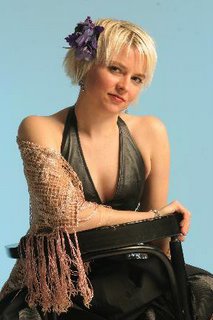
All in all it was an evening to savour and remember and to savour again and remember that I live in Vancouver and that few cities anywhere have such depth of talent.
I would like to point out that all these musicians (alas Julia Wedman is packing her dress and flying back to Toronto) are playing music from XVII & XVIII century France on Friday, May 29 and Saturday May 30 at 8pm at Academie Duello, 422 Richards Street (at Hastings), Second Floor. The performance will be followed by a Theatre De L’Arbre Perche staged production of Moliere’s one-act comedy, “Sganarelle, or the Imaginary Cuckhold” (in English). For more info go here
I have "borrowed" the image of Julia Wedman you see here from I Furiosi's website. I cannot credit the photographer as the photographer is not mentioned.

One of my singular pleasures these days is a routine that began a few weeks ago on Thursdays. I teach at Focal Point (10th Avenue at Sasamat) from 2 to 5 and from 7 to 10. Initially I did not know what I was going to do with those two hours. But then Abraham Rogatnick lives a block away. I suggested we meet for coffee or tea. He suggested a tea house on 10th owned by a Taiwanese woman who lived many years in Brazil. They have a cute waiter, from Lyon, with black rimmed glasses who looks like Elvis Costello. We call him Elvis. He serves me a strong Kenya Kemba tea and a grilled eggplant sandwich. Abraham has an English Breakfast tea with palmiers (he orders extra dark ones). We chat for an hour and then we walk slowly to his house, we chat some more and soon I walk to school and I get there at 6:55.
Today was almost as pleasant as other Thursdays as the routine sets in. A pleasant routine can be ever more so by the fact that it is one. But our routine had a sad tone. Arthur Erickson died yesterday.
The first person Abraham Rogatnick met when he came to Canada from Boston in 1955 was Arthur Erickson who at the time was living in Chilco Street. Abraham knew him well. They were good friends and just about the same age. Arthur was 84 and Abraham is six months older and 85. Abraham told me many stories about Erickson. The one salient fact was that Abraham saw his friend lose his cool only once in all those years. It seems that the Erickson the architect (Rogatnick is also an architect) was mostly a kind person who rarely spoke ill of others.
We discussed the idea that in Canada we had Pierre and Arthur and that they were perhaps the only two people (at least in BC) that one could discuss by their first name and most would know who one was talking about. Abraham further suggested another Pierre (Berton) but I am not that sure.
My relation with Erickson consisted of multiple studio sessions where he faced my camera. I had in most cases lots of time for conversation. I like to question him on his opinion on the Spanish architect Felix Candela. I asked him once if Candela had influenced him and he answered me with a silent smile.
I told Rogatnick that the first time I photographed Erickson it was at the Museum of Anthropology in the early 80s. I had showed up early and taken several Polaroids of different locations. When Erickson arrived I placed the Polaroids on the floor and asked them to choose the ones he liked. His favourite was one by Bill Read’s Raven. He liked my low angle. When I photographed Erickson with that low angle the sculpture did not show. Behind Erickson there was pure architecture with no artifacts. Rogatnick, excitedly told me that the Raven sits on a covered gun emplacement. Erickson did not want to remove any of the gun emplacements built to defend Vancouver from a possible WWII attack by the Japanese. He left most of them intact and built around them. Only in one did he build over.
My two fun stories involving the architect also involve my granddaughter Rebecca. She may have been around 7 when we were invited to a garden party at Erickson’s West Side house. Snacks were served in a long table between the kitchen and the living room. Rebecca went to the living room and sat on a prominent wing chair. A woman came up to me and said, “Don’t let her do that. That’s Arthur’s chair.” Erickson heard, he smiled and said nothing. I then brought Rebecca and introduced her, “Rebecca this is Arthur.” Rebecca answered, “He cannot be Arthur. King Arthur had hair.” Erickson was sometimes a tad deaf. He was this time, “What did she say?”
The second story happened at the Museum of Anthropology at a July 2007 opening of the works of Michael Nicoll Yahgulanaas. After the show, food was served outside that included hamburgers made on the spot. There was also homemade root beer, potato salad and cookies. I was sitting with Erickson on a rock enjoying my hamburger when Rebecca showed up. By then she was 10. Erickson looked familiar but she could not place him. I told Rebecca, “Ask this man what his involvement with this place is.” She did. Erickson answered, “I built this place. I am the architect."
Whenever Erickson would appear at some conference or lecture, I always went to them. It was always a treat to listen to a man with intelligence and humour. He liked to shock and challenge with some of his ideas. I was never disappointed.
Even though he was a handsome and elegant man and many of my photographs captured that, I will always remember, more than anything, that voice. He had a voice. When Erickson talked you had to listen.

In the 50s I used to watch cowboy tenors Jorge Negrete and Pedro Infante play tough cookies in Mexican westerns. They were as tough as John Wayne ever was but in order to prove their manhood they rarely resorted to fists or guns. They grabbed their guitars and extemporaneously insulted each other with on the spot lyrics. It would seem that conflict was resolved in a more peaceful manner south of the American border. I remembered these films tonight at a concert of virtuoso string concertos from 18th century Italy.
A tune that came from Europe’s past (some indicate it came from Portugal) which was the story of a mad or bewitched woman became a melody, called La Follia and sometimes La Folia or plain folia. It was borrowed and appropriated by Lully, Corelli, Geminiani, Vivaldi and even an amateur English violinist, John Playford. Playford published violin music in the 17th century which featured a composition, Faronell's Division on a Ground which is a dead ringer for La Follia. I wrote about La Folia here
Tonight I heard a live version, Vivaldi’s Sonata in D minor, Op. 1 no. 12 “La Follia” for the first time. It was so good that somehow it induced a nose bleed and I had to use very quiet nasal suction to keep it in check!
The group that performed it at St Jude’s Catholic Church, Saint Jude’s Pro Musica, was founded by harpsichordist/organist Michael Jarvis with help from baroque violinist friend Paul Luchkow (photograph, top left). Angela Malmberg also played the violin with Glenys Webster on the viola. A serious Curtis Scheschuk played and carried his large violon hither and thither, while Natalie Mackie did double duty and double time (in that La Follia!) with her viola da gamba.
But Saint Jude’s Pro Musica had a surprise in store in guest violinist Julia Wedman (Tafelmusik, I Furiosi, etc). Not by luck but by complete intention my friend Graham Walker and I sat down in the front row, left. This put us four feet from the guest violinist and when Paul Luchkow soloed Pietro Nardini’s (1722-1793) Violin Concerto VI in F major, Op.1, No. 6.
Violinist Julia Wedman, short, slim and very well shaped appeared in a teal, tiered, dress and a little black top. Paul Luchkow described it as being “mermaidish”. She had a short bleach blonde Joan of Arc cut and little black flat shoes. I don’t usually describe what a musician wears but here it is most important. When Wedman played she reminded me of a cobra emerging from basket. At the same time she was all passion, fun (she smiled often) and her technique, flawless to this amateur, seemed to come from total confidence in her abilities.
The first movement, Largo, of the first piece by Tomasso Albinoni’s (1671-1751) Sonata II in C major from Sinfonie a 5 in C major, Op.2, No. 2 (remember her violin was a mere four feet away) had me holding back tears knowing I had no handkerchief (and how was I to know that blood would follow?).
It escapes me why the majority coming to an intimate concert in a smallish church would not want to sit where we were sitting. I could hear Wedman’s violin here, and then I could hear the response from Luchkow’s violin there. This music is best appreciated as a small contest, a give an take between musicians who are standing. They are almost in an in your face presence. I feel that I am not just a spectator but part of the electricity.
While I can enjoy and did enjoy some weeks ago the Vancouver Philharmonic Orchestra’s extra loud (the way I like it!) version of Shostakovich’s Symphony No.5 there are times when I don’t want to listen to musicians in unison. This is why I also love baroque music. And I love to listen to the quiet notes of a violin. Tonight I could even hear extra quiet but very clear secondary undertones from both Wedman and Luchkow.
Vivaldi’s La Follia almost topped that Albinoni for me. It had Wedman on the left in her dress (that dress!) and Paul Luchkow in smart tails on the right. Between these dueling violinists were harpsichordist Jarvis (with his trademark candy red eyglasses) and viola da gambist Natalie Mackie (the former viola da gambist Nan Mackie I might add). It was a killer virtuoso performance by all four. At one point Mackie and Jarvis were going so fast that I prayed they had not forgotten to apply some extra Mitchum.
From my point of view Wedman won the dueling violins performance. But to be fair let me add the following:
Paul Luchkow told me, “From the moment I saw Wedman’s dress I knew I didn’t have a chance.”
Michael Jarvis explained, “Vivaldi wrote the music so that the violin on the left would win.” And he insisted by repeating, “It was in the music.”

All in all it was an evening to savour and remember and to savour again and remember that I live in Vancouver and that few cities anywhere have such depth of talent.
I would like to point out that all these musicians (alas Julia Wedman is packing her dress and flying back to Toronto) are playing music from XVII & XVIII century France on Friday, May 29 and Saturday May 30 at 8pm at Academie Duello, 422 Richards Street (at Hastings), Second Floor. The performance will be followed by a Theatre De L’Arbre Perche staged production of Moliere’s one-act comedy, “Sganarelle, or the Imaginary Cuckhold” (in English). For more info go here
I have "borrowed" the image of Julia Wedman you see here from I Furiosi's website. I cannot credit the photographer as the photographer is not mentioned.
A Sad Tone To A Pleasant Routine
Thursday, May 21, 2009

One of my singular pleasures these days is a routine that began a few weeks ago on Thursdays. I teach at Focal Point (10th Avenue at Sasamat) from 2 to 5 and from 7 to 10. Initially I did not know what I was going to do with those two hours. But then Abraham Rogatnick lives a block away. I suggested we meet for coffee or tea. He suggested a tea house on 10th owned by a Taiwanese woman who lived many years in Brazil. They have a cute waiter, from Lyon, with black rimmed glasses who looks like Elvis Costello. We call him Elvis. He serves me a strong Kenya Kemba tea and a grilled eggplant sandwich. Abraham has an English Breakfast tea with palmiers (he orders extra dark ones). We chat for an hour and then we walk slowly to his house, we chat some more and soon I walk to school and I get there at 6:55.
Today was almost as pleasant as other Thursdays as the routine sets in. A pleasant routine can be ever more so by the fact that it is one. But our routine had a sad tone. Arthur Erickson died yesterday.
The first person Abraham Rogatnick met when he came to Canada from Boston in 1955 was Arthur Erickson who at the time was living in Chilco Street. Abraham knew him well. They were good friends and just about the same age. Arthur was 84 and Abraham is six months older and 85. Abraham told me many stories about Erickson. The one salient fact was that Abraham saw his friend lose his cool only once in all those years. It seems that the Erickson the architect (Rogatnick is also an architect) was mostly a kind person who rarely spoke ill of others.
We discussed the idea that in Canada we had Pierre and Arthur and that they were perhaps the only two people (at least in BC) that one could discuss by their first name and most would know who one was talking about. Abraham further suggested another Pierre (Berton) but I am not that sure.
My relation with Erickson consisted of multiple studio sessions where he faced my camera. I had in most cases lots of time for conversation. I like to question him on his opinion on the Spanish architect Felix Candela. I asked him once if Candela had influenced him and he answered me with a silent smile.
I told Rogatnick that the first time I photographed Erickson it was at the Museum of Anthropology in the early 80s. I had showed up early and taken several Polaroids of different locations. When Erickson arrived I placed the Polaroids on the floor and asked them to choose the ones he liked. His favourite was one by Bill Read’s Raven. He liked my low angle. When I photographed Erickson with that low angle the sculpture did not show. Behind Erickson there was pure architecture with no artifacts. Rogatnick, excitedly told me that the Raven sits on a covered gun emplacement. Erickson did not want to remove any of the gun emplacements built to defend Vancouver from a possible WWII attack by the Japanese. He left most of them intact and built around them. Only in one did he build over.
My two fun stories involving the architect also involve my granddaughter Rebecca. She may have been around 7 when we were invited to a garden party at Erickson’s West Side house. Snacks were served in a long table between the kitchen and the living room. Rebecca went to the living room and sat on a prominent wing chair. A woman came up to me and said, “Don’t let her do that. That’s Arthur’s chair.” Erickson heard, he smiled and said nothing. I then brought Rebecca and introduced her, “Rebecca this is Arthur.” Rebecca answered, “He cannot be Arthur. King Arthur had hair.” Erickson was sometimes a tad deaf. He was this time, “What did she say?”
The second story happened at the Museum of Anthropology at a July 2007 opening of the works of Michael Nicoll Yahgulanaas. After the show, food was served outside that included hamburgers made on the spot. There was also homemade root beer, potato salad and cookies. I was sitting with Erickson on a rock enjoying my hamburger when Rebecca showed up. By then she was 10. Erickson looked familiar but she could not place him. I told Rebecca, “Ask this man what his involvement with this place is.” She did. Erickson answered, “I built this place. I am the architect."
Whenever Erickson would appear at some conference or lecture, I always went to them. It was always a treat to listen to a man with intelligence and humour. He liked to shock and challenge with some of his ideas. I was never disappointed.
Even though he was a handsome and elegant man and many of my photographs captured that, I will always remember, more than anything, that voice. He had a voice. When Erickson talked you had to listen.
Wednesday, May 20, 2009

When I read a novel I never skip the Forewords the Prefaces or in the case of Robert Wilson’s The Ignorance of Blood, the Acknowledgments.
This is the last book in the Javier Falcón Seville Quartet and I would like to take the opportunity to thank the people of Seville for being so understanding at having all this fictional mayhem created in the streets of their beautiful and, comparatively, tranquil city…
My thanks to the brilliant Mr. Ravi Pillai and his assistant, Dr. Hassan Katash, whose surgical skills have kept the Robert Wilson show on the road...
I would perhaps be awfully pessimistic that Wilson’s last Javier Falcón novel (The Blind Man of Seville, The Silent and the Damned, The Hidden Assassins are the previous three) is somehow connected to Mr. Wilson’s health. I suspect that the case may be that he wants to write about other things. After all Wilson has written six other novels that have no connection with Seville and which I enjoyed tremendously. Perhaps Seville (or Sevilla as I prefer to think of it) has taken his Inspector Javier Falcón away from him much in the same way that Alec Guinness took George Smiley away from John Le Carré.
Sevilla can be that possessive. After all, the gold (and silver) of the new world in caravels and galleons went past San Lucar de Barrameda, at the mouth of the Guadalquivir River, a port that concocts its own pale gold, the bone dry manzanilla, and navigated the 80kms to the Puerto de las Indias in Seville. Madrid was just a town.
Spain squandered in Flanders all that gold and silver. But other treasures remained.
There were documents and maps that were housed in Archivo de Indias (The Archive of the Indies). My Manila born uncle, Don Luís Miranda often told me of his trip to Seville to this wonderful place that houses more than 53,000 documents and 8,000 maps and drawings. Accounts in the handwriting of Cortés, Pizarro, Balboa and Magallanes are there. I would suspect that the first maps that gave our new world its name, those drawn by Amerigo Vespucci must be there, too. The place conjures a marvelous world when Spain was its centre.
My first experience with Seville happened in 1985. Rosemary, Ale, Hilary and I stayed at the recently refurbished Alfonso XIII Hotel which was opened by that very king in 1929. Many of the European nobility stayed in the hotel in its glory days as did the best bullfighters that fought at la Plaza de Toros de la Real Maestranza de Caballería de Sevilla and the American author, Hemingway who was writing their story.
Perhaps it was because my daughters spoke English that the staff of the hotel thought we were Americans. They looked at us with stiff disdain and I could think their thoughts, “You Americans are defiling this great hotel that has seen so much Spanish history. Leave us your Dollars and go home.”
As much as I wanted to like Seville, I didn’t. I was tempted. At Santa María Cathedral I gazed on the tomb of Christopher Columbus. I was born in Buenos Aires and until I came to Vancouver October 12th was a holiday, el día de la raza or the day when a new race was born(the spin in those days was that the intermarriage between Spaniards and native Americans produced a superior race, even though mostly the whites, the Spaniards always seemed to be in charge.) Even the tomb was not all that satisfying. It seems the Admiral of the True Oceans’ body was divided a tad and part of his body is in the cathedral in Santo Domingo in the Dominican Republic.
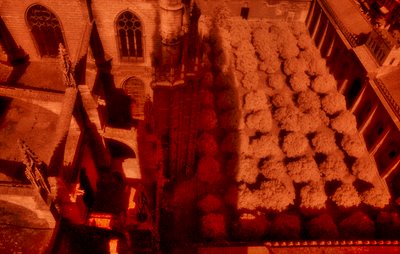
Suffice to say, that Seville has never appealed to my mind but only a bit to my heart. In my heart is that black lace mantilla that my grandmother bought in Seville and always wore to cover her head when she went to Mass. It was with that mantilla that I photographed my oldest daughter Ale.

I fell in love with Seville because Javier Falcon's city, as written by Wilson, somehow became my own. As this Vancouver winter lingers into a cold spring I long for the hot days that Inspector Javier Falcón sweats in, loves in, eats, fights the bureaucracy of the Spanish judicial system and sometimes even drinks. Falcón mentions the heat but never complains.
It was at the bell tower of that Cathedral of Santa María, the Giralda that I also photographed Ale. You can see her at the bottom of the reddish picture. The other photograph is a the Patio de los Naranjos (Courtyard of the Orange Trees) adjacent to the cathedral and seen from the top of La Giralda which projected its shadow into the scene.
Perhaps soon I can return to Seville and see the city through the eyes of that melancholy man, Inspector Javier Falcón. His city would warm my heart.
Burriana, Seville Oranges & Dundee Orange Marmelade
Seville, Oranges, La Giralda, Spooks, Robert Wilson & A Sumo Wrestler

Last Saturday Rebecca told me,”I want to go to the English car show at VanDusen.” Anything that Rebecca might be interested in that is out of the normal for a girl her age I applaud. Rosemary, Lauren, Rebecca and I went to the show. We were unaware that the show was going to close at 4 when we got there at 3:15. The first cars we looked at were the Morgans. There were 55 of them including three, three wheelers!
Because the show was going to close I told Rebecca, “Let’s go to see the best car here. I knew exactly were to go. I went to the upper area of the garden where they usually display the Lagondas. I was looking for Liz Haan and Bill Holt’s maroon 1939 Lagonda V-12 Sedanca Coupé. This car won the best in its Lagonda Class at Pebble Beach in 1999. It is perfect. Some years ago I had taken my young daughter Ale to see Ed Aveling’s convertible and supercharged Auburn. Ale looked at the car and said, “Daddy why don’t new cars look as new as this one?” If Ale had been with us she would have said the same thing about the maroon Lagonda.
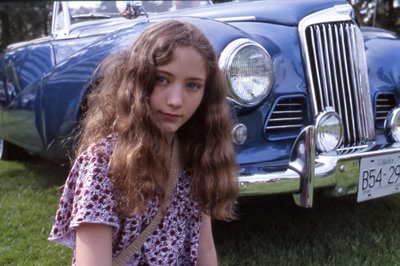
Lagondas are rare cars because few were made. The Holt/Haan Lagonda is especially rare. Consider that it was specially ordered by the King of England in early 1936 and by the time it was delivered to him in New York in 1939 he was the Duke of Windsor. After the war the car exchanged many hands and ended up as property of the wife of a man who owned a North Vancouver car dealership. It was in a terrible condition and it could not be driven.
The maroon Lagonda that Rebecca and I inspected was spotless. We showed interest and in particular I was staring at the beautiful running boards with the chrome strips. Bill Holt came up to us and opened the trunk. He opened a beautiful case lined in green billiard felt. In it was what looked like a brand new tool kit. Holt told us, “I searched through Europe for a year to complete this.” Since Holt is a retired psychiatrist I was not about to question his unusual obsession.
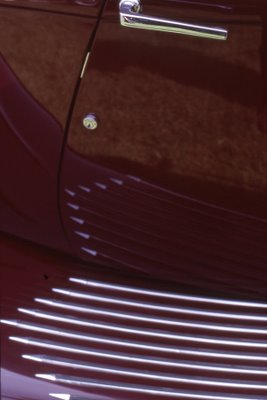
Lagondas are unusual in many ways. The body of the maroon Sedanca is of aluminum laid on an ash chassis. The engine and its racing package was installed in 2 Lagondas (much lighter than this car’s 5000 pounds) that ran in the 1938 Le Mans. I asked Holt if the Duchess would have sat in the back seat. “No, she would have been in the front as the Duke drove the car.” I asked Liz Haan if she ever drove it . “I sometimes do but it is almost impossible for me to park it.” Of course the Lagonda has no power assisted steering.
From the Lagonda Rebecca took me to see a lineup of Sunbeams, Sunbeam Alpines and Sunbeam Tigers. Rebecca was attracted to the plain Sunbeams (not plain at all) and properly called “Proper Sunbeams”! The light blue one you see here has an interesting story. A car exactly like it and in the same colour was driven by Grace Kelly in To Catch A Thief. I did not pursue with Rebecca the Sunbeam Alpine that caught my eye. It was red with a black top. The owner confirmed my suspicions. “Yes it is exactly like the one Elizabeth Taylor drove to her death in Butterfield 8, Daniel Mann’s 1960 film with Lawrence Harvey and Eddie Fisher. The scene where Taylor grinds the heel of her pumps into the front of Harvey’s shoe is a scene that I have never forgotten for its implied pain and eroticism. Rebecca will have to wait a few years before we see that film together.
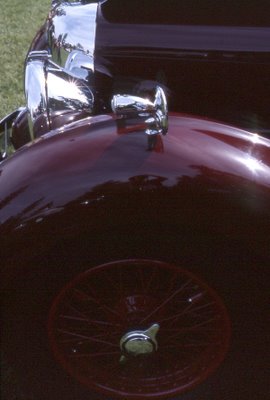
I do apologize to Bill Holt and Liz Haan for my photographic travesty of their beautiful car. I simply spent too much time on the unusual running boards. Perhaps the next time I just might get a bit more of it. This situation reminded me of one of which I wrote here.
whet
/wet/
verb (whetted, whetting) 1 sharpen the blade of (a tool or weapon). 2 excite or stimulate (someone’s desire, interest, or appetite. Origin: Old English.
Compact Oxford English Dictionary

It has only recently that I finally caught on that one whetted one's appetite with that word that included an all-important h. I looked it up today. Coincidentally I was having problems cutting off my damaged rose leaves (the pesky winter moth) yesterday because my Swiss Felco secateurs were not sharp.
When Rosemary and I went to a nursery yesterday I decided I was no longer going to buy a brand new replacement blade for my rose cutters. I paid $22.00 (almost the price of a new blade) for a neat Felco whetting stone. And yes it has that h as it seems the verb has all to do with sharpening either taste or a blade.
Since we began to garden in our Athlone Street house in 1986 we have gone through countless garden tools, lawn sprinklers and a few secateurs. Sooner or later like in almost anything one does, one comes to the realization that the best is almost always the most lasting. Ever few weeks I cannot find my Felco. But I use Rosemary’s trick of remembering where I used it last and I always find. Unless I lose it the Felco secateurs and its whetting stone (made of aluminum oxide) will be the last I will ever buy. If Rosemary wants to she can bury me with them with my hat off to the Texan who was buried with his Cadillac.
When Lauren is excited about some event she always asks Rosemary, "How many sleeps?" Lauren's calendar is made up of days that are separated by her sleeps. In a similar way I ask myself, "Will this be my last Felco?" In a similar vein I have figured that had I not had a little accident a few years ago I would be a Two Spotone Bottle Man. What's that?
The three litle bottles here contain a liquid (Number 1 is a blue black, Number 2 is a sepia and Number 3 is a neutral black) that when applied with a fine brush (there are two here, very dark on the left side) will hide or eliminate the dust marks that appear as white dots on b+w prints, printed on an enlarger. When I was 20 I bought my first set of Spotone. Then about 15 years ago I spilt Number 3 (the most useful colour) and had to buy a bottle. I calculated that the spilt one was the second I had ever bought. A photographer's life span could thus be measured (without an accident) as a two-Number-3-Spotone-bottle life.
The little ceramic tray at the bottom is where I dilute the Spotone gradually by dunking my brush in water and dabbing the indentations. This gives me different degrees of black to a light gray. On the other side (the bottom) I mix my Number 3 in the same way for sepia prints.
For my negative and transparency scans and for the scanned artefacts you see here there is always dust that appears as white little dots on the scan. Spotone does not do the job. I rely on two Photoshop tools. One is called the clone stamp tool and the other the healing brush tool. As Photoshop is constantly being replaced by a new version (mine is plain Photoshop CS) it would seem that it would be next to impossible to be a 3 Spotone Bottle Man in the digital age. I can confidently assert that I will not buy one more bottle of the stuff.
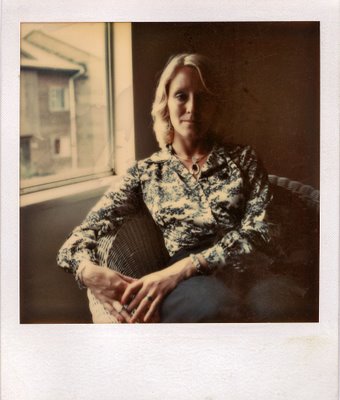
My first cousin Willoughby Blew and his wife Chris visited us from Florida (they are on their way to an Alaska cruise) on Friday evening. Hilary, Lauren and Rebecca were present and Bruce Stewart, who was working, arrived a bit before dessert. We had a “sobremesa” (literally on the table) which is a beautiful word that describes a pleasant conversation after a nice meal. Both Chris and Willougby seem to crave that family sobremesa that we may have observed when all of us were children but were too small to participate.
The original plan was to eat out but in the end we settled for a quick tour of our garden and a relaxed meal at home. It was all so pleasant that it made me think of family more than my usual. As I was looking for those two pictures of Rosemary for yesterday's blog I found this yellowish/green/cyan SX-70 Polaroid. By the window, I know I must have taken this in our Burnaby home between 1975 and 1977. Rosemary is wearing her colorín necklace and she seems to have a band aid in her right hand. Jaime Vidal, a Spanish jeweler and friend in Mexico City not only designed the colorín jewelry set but he also made our wedding rings. They are of gold with an exterior band of fired enamel. Through the years the enamel has chipped off and as our fingers have thickened with age we can no longer wear them. On her left wrist Rosemary is wearing a beautiful jeweled watch that my father gave to my mother. My mother often told me the story that this was the only object given to her by my mother that was left. He had pawned just about everything else to pay for his alcoholic habit. My mother had a talent for breaking watches so she rarely used it except for special occasions. I do remember that the watch mechanism has been repaired a few times. Since Rosemary inderectly inherited from my mother the special talent for breaking watches, she too wears it sparingly.
As I look at this picture of Rosemary where she oozes with elegance and intelligence I can remember the first time I saw her in 1968. She was teaching English at a school where I was teaching. I saw this blond vision (remember I am a Latin!) wearing a very short mini skirt. Her legs rivaled my mother’s in shapeliness. The rest is family history and I would not change any of it.

Rosemary says we should be brutal in our family picture filing.
consider the two pictures here. The negatives plus many other pictures I took on the same day are all in negative sleeves. A couple of them from this date (sometime in 1971 in Arboledas, Estado de Mexico) are in our family album. We have three family albums. One incorporates the old pictures of my family beginning around 1878, Rosemary’s picture of her family and then the pictures of us together wich span from the beggining of our relationship to our marriage, Mexico and our drive to Vancouver. There the album stops. Ale, our oldest daughter has an album as well as Hilary and both of theirs also finish in Vancouver. From that point on we live in shoe boxes and a few, the really good ones in pewter frames on our piano or framed on the wall. But the negatives and slides are all carefully filed under years in my multiple metal cabinet filing system.
Rosemary says we should pick one or two of a session and throw the rest away. I am not sure she is right. On the other hand there is a tintype of some late/middle 19th century relatives of Rosemary. She has no idea who they are. At that point we could throw it away (except for the intrinsic value of the original tintype it is). I feel that after about 100 years (and that span is getting compressed) most of us lose sight and memory of old pictures. In a not too far future, pictures in CDs might not be viewable and even if they are who will know who the people in them are?
Is it worth filing family pictures as Rosemary and I are? When we both go will our daughters chuck them into the Straight of Georgia or burn them in a fireplace? Does it matter?

As it stands here are two that I placed in our album long ago and even then I was undecided which one was the better one so I put both in. I cringe at the idea that we wore his and her identical shirts. I remember that we both wore white jeans and had some white leather high top shoes with a rubber sole that was about four inches thick. I also remember that I was the one who helped Rosemary pluck her eyebrows!
The “art work” behind I made out of lacquered wood mounted on clear Lucite. The colours were white; the bottom bar was orange and the vertical one red. I used very expensive car lacquer and I sprayed it on with a little hinged double-tube mechanism that I used to fix the pastels I made many years before when I painted and had yet to buy a camera. It was my 1970 attempt at modern art.
It is sobering to understand that my archivaly processed prints from which I scanned the images you see here will, if they survive a dunking in the Straight of Georgia or a fire, will perhaps be seen by a descendant who will stare at us, not know who we are and just throw them out. Just like perfect cannot be made more perfect, our deadness will not be more so. But from this side of death it seems even much more final.

One of my earliest memories as a child is the bathroom. It was a large bathroom in our Buenos Aires house on Melián Street. It was a very old house shaped like an L. The short part of the L connected to the main house (living room, dining room and my parent’s bedroom began with our kitchen and beyond it was the bathroom. Since the kitchen with it old black gas stove was the warmest room in the winter I can see why the bathroom would be right next to it. It had a bidet. I did not have any idea of its purpose except at least twice I played with it and a very high pressure jet of water hit the ceiling and destroyed the plaster. I have no memory of the toilet or ever sitting on it. It could have something to do with the fact that children in school and as late as a conscript in the Argentine navy I was called Watercló. The English had left their mark in Argentina with their futbol, their tramways, trains and waterclosets. In an attempt at independent sophistication Argentines had their very English tea at Frenchified Salons de Thé.
I remember being in the tub and watching my mother using an eyecup. It was a strange sort of semicircular glass device with which she cleansed or rinsed her eyes. She would look down into the device and then throw her head back. I was convinced that my mother could pop her eyeball in the cup and wash it all around.
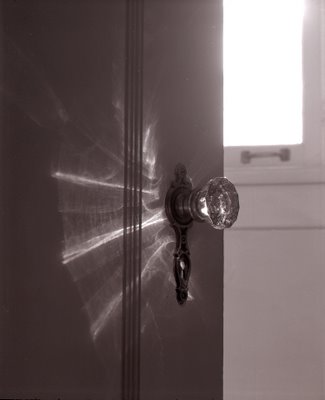
I may have been around 8 when I began to read Pato Donald comics in the tub and discovered the only two really good places to read which is the tub and one’s bed. The toilet should never be used for reading pleasure. It is best used to rid oneself of constipation by sitting down with something very difficult to read. The distraction and concentration of reading loosens up the works.
The tub or the shower is a godsend for the gardener particular this one. I never use gloves. After a few hours of digging and putting my hands in dirt or mixing the manure with compost, my finger nails get filthy. This is when washing one’s hair is most useful. I have several good nail brushes, including a fine nylon one from Lee Valley Tools but none of them work as well in cleaning under my fingernails as washing my hair vigorously with a shampoo.
It was my Manila-born uncle, Don Luís Miranda who always seemed to have more fun than anyone else in the bathroom. He liked to work on the New York Times crossword puzzle “en donde el rey va solo” (where the king goes alone) and he was a legend in our family for singing Gilbert & Sullivan or Puccini while showering. He sang complete arias while showering. He was thorough in his bathing procedure. This was the man who had once told me that he hated going to the beach because sand got into his shoes.
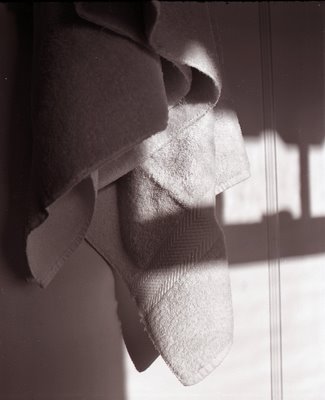
He would have been shocked to find out that I have a fondness for cold breakfast pizza in the tub. As summer approaches I know there will be some special afternoons where the sun will be just right and fracture light as it goes through our glass bathroom door knob. Rosemary prohibited me from hanging towels (especially wet ones) behind the bathroom door as in the picture here. She says that the nice white paint will peel. Luckily I took this picture. I had filed it away and discovered it yesterday. That’s Mark Budgen’s friend Aja (pronounced Asia) in Mark Budgen’s tub. I may have taken that picture about 15 years ago.

Of late Rosemary and I have been filing our family pictures. Until Rebecca was born 11 years ago our files were loose in groups called "early 70s" or "early 80s". But as soon are Rebecca came along and then Lauren I began to take so many pictures that we have now filed them under spicific years. As we file we find pictures that I took that I forgot I took, or I simply never had the time or inclination to go down to the basement to my darkroom to print. Some of those pictures are a revelation and a joy to me.
In 1986 business was good for me. I was working for tons of magazines and there were tons of business magazines across Canada. I was working for all of them. My shrewd wife decided we should move from our comfortable townhouse in Burnaby that had a little garden. “I want to live in a nice house with a real garden,” she told me. She made us move to our present location on Athlone Street in Kerrisdale in 1986. In 1986 I was yet to be jaded by the idea that I should only take pictures for money. So I took quite a few pictures of my daughters Hilary and Ale. The picture of our house shows it in a very early stage when we still had not worked on the garden. We were completely ignorant. Ale had a boyfriend who had a farm in Ladner. He brought us a pile of horse manure one day. I actually, in complete ignorance, manured the laurel hedge you see here not knowing he work that lay ahead to prune it. That hedge wraps around on the right and goes halfway down the boulevard. As my Spanish grandmother would have said, “Ignorance is daring.”

The picture of Hilary (in b+w) has her on the wooden floor of the living room. Next to her was our first Canadian cat, Gaticuchi. Hilary looks beautiful and relaxed. I photographed Ale in Hawaii. We seemed to have some extra money to travel there.
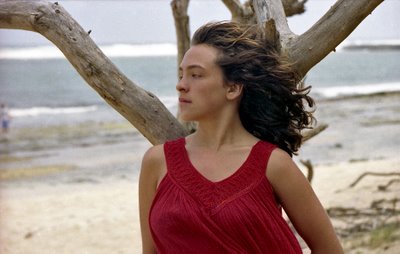
The two girls are gone. Many of the conifers in the picture died of root rot and old age. One thing has not changed. Even though I am now smart enough to never fertilize that laurel hedge, it grows! I will have to tackle it in about a week and it will take about three days using hand sheers. Electric hedge clippers leave a mess as the laurel hedge’s branches are tough and the cuts are not true. The result is messy. I hate the job but I don’t think I would want to return to Burnaby. Rosemary has always been right.
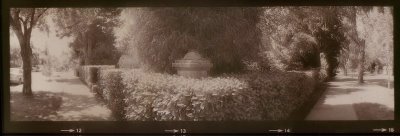

Warning! What is below could be seen as a mild political rant. Do not proceed unless you are partial to rants from citizen/amateur nonentities.
A day after our provincial elections I was lucky to find a photograph sent to me by writer Kerry McPHedran in 1986. The photo, taken by Glen Erikson is of your blogger with the founder and editor of Equity Magazine, Harvey Southam. I have written about Southam before here. But I simply had not pictures of him. He asked me to photograph his mother, his wife and even one of his children but I never pointed my camera at him.
When I went to his memorial service (he died by his own hand in 1992) at Christ Church Cathedral I went for one single reason. I wanted to be present at a place that I thought would represent an end of era. Most of those in the church were white and the minister spoke of summer holidays at the Southam house in Qualicum. Even today a visit to Qualicum is a visit to what now seems to be an uncomplicated past.
There are some of my friends who did not get along with Southam. There are some who say he was nasty to them. I never saw that side of the man. He was always kind and pleasant to me and he indulged me when I wanted to take unconventional photographs for his business magazine. With Southam I met the real decision makers of our city and province. He had access to all of them.
An event in 1991 should have given me an indication of things to come. NDP MLA candidate David Schreck defeated Liberal Floyd Sully in North Vancouver-Lonsdale. In 1992 the Liberals were liberals in the real meaning of the word. Few now will remember or realize that the BC Liberals are really a re-named Social Credit Party. Our Provincial Liberal Party is a conservative party but few will point that out.
I had an admiration for Southam because as a man who had all to gain by keeping the establishment as it was, he had a couple of columnists write on the same theme every month. On the left page was Floyd Sully’s From the Left and on the right there was From the Right with George Froehlich. I do not remember the name of the conservative writer. In those years, the late 80s I would turn to Vancouver Magazine’s last page to read Sean Rossiter’s 12th and Cambie. It was all about city politics but also of subjects dealing, as an example, the engineer who was designing left turn bays at traffic lights or what it was like to check in at the venereal disease clinic. From Vancouver Magazine I would then go to Equity and read From the Left and From the Right. It was always entertaining.
It was also Southam who started the strings of articles that eventually did in the Vancouver Stock Exchange. He hired Adrian du Plessis to write a cover article on the dubious shenanigans of the exchange.

Southam was a man of his times. When I told him that Alderman Bill Yee would make an excellent ethnic city mayor he told me, “Not while I am around.”
A few weeks before he died in 1992 I went to Toronto to look for work with national magazines. I called up Southam’s company around 6 in the afternoon. He answered the phone. We had a couple of cokes near his office and he was as gracious as ever with me.
As I look back to the man, I realize that journalism’s strict sense of ethics has been in a decline. It was only three or four weeks ago that an “entertainment/arts” article in our local big daily had an article in which the executive director of a theatre company interviewed a theatrical director of the company. There was no byline and no explanation. Most of those who are under 30 would perhaps not catch the lapse in journalistic ethics. I have heard rumours of other publications that strongly suggest that buying an ad will guarantee editorial content. Times are tough but there is such a thing as right and wrong. Southam knew that difference and his magazine, gone all these years, looks better and better to me.
When our Liberals are really conservatives how is a voter supposed to know how to vote? A solution is to distance oneself from the “center/right/from left/ but not so much to the left as to the right of the centre” and to clearly call a spade a spade. The NDP could do worse than:
1. A gutsy renaming of the party to the NLP (New Left Party)
2. A milder renaming to The Canadian Democratic Party or CDP. There is absolutely nothing new about that N in the NDP.
With the Commies now the most avaricious and nasty capitalists (we are living the new Dickensian times), what is wrong with being from the left? There is a newness there!
Equity art director, Randy C Pearsall did not want to have any problems with the police. We did not paint the nearby wall to the Vancouver Stock Exchange. He had some transfers made. He carefully stuck them on the wall, I took the picture and we left with no incident.
I consider myself to be both priviledged list and extremely lucky to get the occasional invitation to watch a choreographer's work in progress. It is interesting to see the beginning and intermediate steps (in some cases raw steps) that lead to a finished and polished choreographic work. These works in progress come with explanations, reasons and what inspired them. In the case below choreographer Simone Orlando's talk (she was elegantly dressed to kill!) was preceded by high praise from Ballet BC Artistic Director John Alleyne who also explained how the grant in question works. There was an additional surprise. Her name is Jocelyn Morlock.
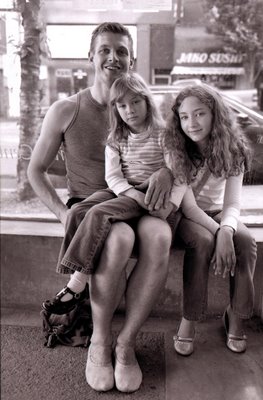
Dear Ballet BC Supporter,
You are invited to attend a FREE, informal showing of a new work by Ballet BC member and choreographer Simone Orlando created through a Fellowship Initiative Grant from the New York Choreographic Institute.
The process, which began on April 20, culminates with this post-work presentation at the Scotiabank Dance Centre on Monday evening. This innovative new work features Ballet BC company dancers Makaila Wallace, Jones Henry, Connor Gnam, Maggie Forgeron, and Leon Feizo-Gas.
WHEN: MONDAY, MAY 11, 2009 @ 5:30pm
WHERE: SCOTIABANK DANCE CENTRE - THE FARIS STUDIO
677 Davie Street Vancouver
This is an open-invitation event, so please feel free to bring and invite friends.
"Ballet BC has been awarded a Fellowship Initiative grant from the New York Choreographic Institute, an affiliate of New York City Ballet, to support the development of new choreography in a studio setting. The choreographer will be Simone Orlando. Peter Martins, Founder and Artistic Director of the Institute states: 'The Fellowship is meant to help ballet companies to create an environment in which a choreographer can develop ideas without the pressure of stage production. The Institute is committed to classical choreographers who will be creating works for the future."
Lauren, Rebecca and I arrived early so that we could sit up front centre. At the Farris Studio this means that your feet are on the dance floor. Rebecca no longer has to explain to anybody, as I do, that we like to hear dancer's gasp for air and see the sweat on their bodies. We did manage to sit in that front row but not before I greeted young Vancouver new music composer Jocelyn Morlock. I could not figure out why she was there. Then I spotted trombonist and co-director of the Turning Point Ensemble, Jeremy Berkman and in another area of the studio composer Owen Underhill who is the musical director of the Turning Point Ensemble. I was intrigued. Lauren was dead serious staring at the five Ballet BC dancers who were warming up (one of the nice extras of being in a work-in-progress situation).
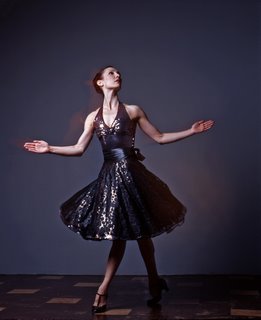
Simone Orlando, above centre, set us straight when she mentioned that her ballet was based on two pieces of music. One was Antonin Dvorak's Piano Trio in E Minor, Op 90 "Dumky" (1891) and the other (aha!) Jocelyn Morlock's I Conversed With You In A Dream. Morlock's work is inspired by Sappho's fragmentary poems. It is a duo for flute and piano. The version we heard was with pianist Rachel Iwaasa and flutist Mark McGregor, below right.

The Dvorak piece had lots of classical ballet which contrasted so nicely with Morlock's music as Orlando incorporated more modern ballet into her dancer's movements. Complicating matters rather nicely, Orlando could only use five dancers, so many of them (in a work full of Greek gods and godesses) played more than one god. Jones Henry seen here with Rebecca and Lauren played both Zeus and Hephaestus (god of fire and especially the blacksmith's fire).
My girls behaved. The afternoon was most pleasant. My only regret, while watching
dancer Makaila Wallace, was to wonder why I have never had the opportunity to photograph her. She is Vancouver's epitome of the classical ballerina (but so sumptuously well shaped, nonetheless!) now that Andrea Hodge has retired from active dancing.
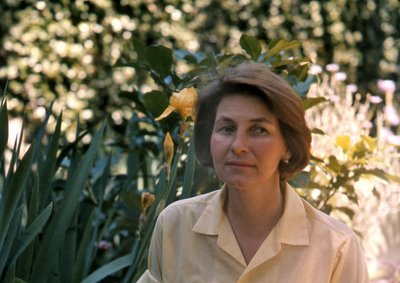
My godmother and first cousin, Inesita O'Reilly Kuker has been in my thoughts of late. I wrote most recently about her here.
She has been in my thoughts for several reasons. One of them is that she did get the audio book I sent her mentioned in the above link. She was delighted and it seems she has listened to the book twice.
The whole odyssey of trying to solve my godmother's reading problem began a few months ago when she went on a vacation to her apartment in Punta del Este, Uruguay. She returned and soon after her son Georgito arrived to pick her up to take her for a weekend family gathering. He was shocked. Her face was all black and blue and her eyes were bloodshot. The independent soul that Inesita (she is 85) is prevented her from telling anybody that she had fallen in Uruguay. Her son took her to see a doctor who confirmed that she had a blood spill in her eyes. He injected her eyes and told her it would take at least 6 months to regain her full vision.
Most of my other cousins told me I should mind my own business and that Inesita did not need to read. It would seem that even though they live in the same city with her (Buenos Aires) they don't know how important reading can be for someone, or how important it is to read in one's chosen language. One of my cousins told me to get her a subscription to a large print Reader's Digest. For once diplomacy ruled and I did not bother to tell her that Inesita would never read Reader's Digest in any form be it small or large print.
As I have often written here Inesita would have been categorized by my mother as "gente fina". It is as difficult to translate as the Spanish word educación. The primary meaning of this word is a combination of well-mannered/good upbringing and poise. Gente fina adds to the mix a bit of knowledge of the arts and the person would have to be well read. Inesita, as gente fina would never acknowledge liking or reading the Reader's Digest. And that was exactly the case when I told her, jokingly, that I might get her that subscription. "Don't even think of it."
In Vancouver I admire those in the modern and ballet dance community because I can say with almost no exception that the majority that I have met have this poise, this presence that my mother so often told me was a rare thing. I would have liked my mother to notice that I am trying to make Rebecca and Lauren, gente fina. So we go to dance and theatre and I coach them on table manners!
Today I went to the main post office and mailed Pride and Prejudice read by Jenny Agutter, Daphne Du Maurier's Jamaica Inn read by Samantha Bond (Pierce Brosnan's Miss Moneypenny) and Angela’s Ashes read by the author, Frank McCourt. I wish I could be there when they get to her.
The other reason that I have been thinking of Inesita is that this Friday I will have Willoughby Blew and his wife Chris for dinner. They live in Florida and they are going on an Alaska Cruise. Willoughby Blew is my first cousin. As a young man in the Argentine navy I had a crush on his sister Elizabeth. Rebecca has met my three Buenos Aires cousins, Inesita, Diane and Elizabeth. With Willoughby the list will be complete (there were four more but they died) and when she grows up she might remember enough to keep our family story going.
I told Willoughby I was going to make a cheese fondue. This was his reply:
Dear George,
As you can well imagine we are in your hands when it comes down to deciding where to eat in Vancouver. Either the restaurant (Next) you recommend or the fondue dinner at your home are fine with us and we will leave the final decision up to you. Whatever is easiest and best for all is OK with us.
I'm assuming your fondue is made with equal parts of Gruyere, Ementhaler and Appenzeller cheeses complemented with Neuchatel wine, kirsch, black pepper, nutmeg and garlic. I remember eating cheese fondue practically on a daily basis when I lived in Zurich back in 1969. I just could not get enough of it.
How on earth do you know it will be a rainy day in Vancouver on Friday, May 15? I know that the law of probabilities says it will probably rain but then "the exception makes the rule".
Willoughby
Rosemary is in a bit of a panic as she thinks Willoughby is some sort of perfectionist. Consider what he said of the wine I was planning to serve:
Dear George,
The Hayward "bug" is among us but has never deprived me from enjoying a good glass of wine. Moderation is the word.
The taste of "green grapes" you refer to when you drink a Torrontés is exactly what makes this wine similar to a Gewutztraminer from Alsace. Some people love this flavour and some hate it.
Bodegas Etchart, also from Cafayate, Salta makes a very good Torrontés called "Etchart Privado". I have not seen this wine in the US for some time now. This may be the "reserva Especial" you referred to.
Given that you will drink wine in moderation if it is a Torrontes and given that we have now settled on having your famed fondue would you like me to bring a couple of bottles of whatever Torrontés is available at your local Government store.? A simple yes or no will do.
Manzanilla of course is a sherry and therefore somewhat higher in alcohol than most still wines. I was rather shocked to read (three times) that you pour your half bottle of San Lucar de Barrameda Manzanilla into a soup bowl to drink. Most folks find that a small glass of this sherry makes for a good aperitif. I have never heard of anyone drinking it by the bowlful but then, cada loco con su tema. So much for the Hayward "bug".
Rosemary's Pavlova with dulce de leche sounds wonderful and dietetic to boot.
We are also looking forward to our reunion.
Willoughby
Because I insist in calling Willoughby by his middle name, James, he calls me by my first name, George. I look forward to our family dinner. One of the toasts will surely be to another "gente fina" and that's Inesita our first cousin.

I have not always succeeded in maintaining a distance with my students but I try very hard. At the two schools where I teach photography, Focal Point and Van Art I tell my students that if they want to communicate with me they can forward me e-mails through the administrator of the photography department. Only last week a female student asked me if she could address me as “Sir Alex”.
In years past phone numbers were either more difficult to get or easier. Most people were in the phone book unless the number was unlisted. Now, with many having cellular phones, that phone number is hard to get. But if one has a web page (and I have one) my students can find either my phone or a method of e-mail communication called contact submission.
I would further define our age of instant communication as an age of quick intimacy. I blog and in it I write personal stuff. Students call me Alex instead of Mr. Hayward. For years in Mexico I addressed my students as Mr. or Miss. This idea is pretty well gone unless you are in a Canadian Armed forces boot camp.
So I had to give it much thought when a part-time student (over 20) waited until the last class to ask me if I would photograph her. I run photography as a business and I cannot reject work simply because I might have an over-sensitive concept of what a teacher student relationship should be. Technically when she came to my studio she was no longer my student.

Roksana was Polish and lived in London. She was a banker. She sat in the front row of my photography class and I don’t think she ever wore the same pair of exquisite shoes twice. In my mind she was a James Bond girl. She looked like a James Bond girl, she dressed to kill and seemed to live a jet set life (I define here jet set in the old term when flying was exciting and sexy). To top it all she was a good photographer.
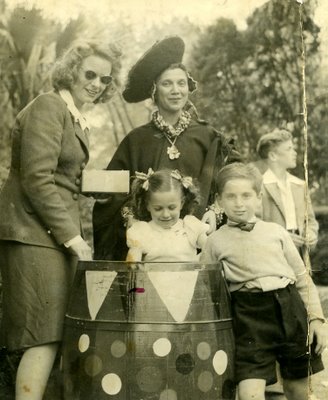
When Rebecca arrived at noon today for her piano lesson (we have a Chickering baby grand in our living room so her classes are here) she said, “I want to go to Mayfair.” Mayfair in our neck of the woods is the annual fair held at the nearby Catholic private school Vancouver College. There was no way I was not going to please Rebecca and Lauren (she also wanted to go) on this wish. Sometimes I rent a movie but it seemed a shame to stay inside on a beautiful day like the day today was. So Rosemary and I took the kids to Mayfair. I strapped a couple of Nikon FM-2s around my desk. “You look like a tourist!” Rebecca said. I countered, “With these film cameras I don’t look like a tourist, I look like an old man.” I joked with Rebecca that the reason she wanted to go was to ogle the handsome private school boys. This did not seem to be the case. “I want to go on the bungee cord jump.” Lauren said, “And I want to go into the Pirate Ship.” It seemed harmless enough. We walked.
It was a bit of letdown as memories flashed in my head of fairs in the American or English schools in Buenos Aires and in Mexico. They had all kinds of treasures, Mickey Mouse comic books in English (can you imagine that!) and later in the 50s used Tom Corbett Space Cadet or Hardy Boys mystery books.
At the Mayfair they had boring games (the exception was the bungee cord for which Rebecca waited close to 40 minutes on a long queue) and lots of food. The gym was full of junk by the time we got there mid afternoon. But Rebecca enjoyed her three minutes on the bungee cord jump and while she made several back flips she refused to make any front ones. Not having a digital camera I have no idea what my pictures will look like.

Back home I instructed Rebecca to write in a notebook the location and state of every rose in the garden. If the rose was missing a tag, Rebecca printed out its name in her very neat writing. The purpose of the exercise was to prepare her for our joint appearance in the forthcoming World Rose Convention in Vancouver in late June. Our lecture is called A Rose Through a Child’s Eyes. Rebecca has to learn more about roses. During our work she said, “This is like studying except it is fun.” Part of her job was to assess the condition of the rose bush and to mention if it had scent, how powerful that scent was and if it was fruity or myrrh, not to mention the colour and shape of the flowers. We finished our day with barbecued chicken, white rice and sliced ripe tomatoes. After our meal Hilary surprised us with a DVD called Miss Potter which we all enjoyed. Taking them home I was again hit by waves of memories of those former fairs and of one in particular in 1951.

That year my mother was teaching at the American High School. I was going to the nearby (two blocks) American Grammar School. Only in recent years have I finally come to understand that I never ever went one day to a public school and that my mother always found ways of sending me to private schools. She must have had a deal that by teaching at the high school (she was loved and appreciated and the school annual for 1951, The Southern Star is dedicated to her) I did not pay to go to what must have been an expensive school.
As soon as I got home I went to the family album in search of a picture that I remember was taken that year at the school fair. In Spanish we called it a tombola. In back of the picture here (my mother is in the middle with the funny hat) it says barrel pull. I think it may have been filled with sand or saw dust and the little boys in the picture bought tickets to then take their chances of finding “valuable” prizes.
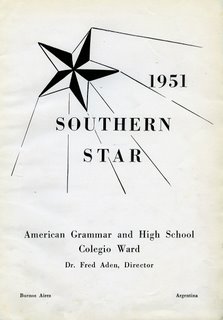
Perhaps they didn’t have the exciting games they had at Mayfair but through a child’s eyes it must have been every bit as exciting. At Mayfair I noticed lots of 14 year-old girls with great big fronts of metal in their mouths trying not to notice the boys that were trying not to notice them. At age 9 it must have all gone over my head in that fine afternoon at the American School in Buenos Aires.

I noticed that the Southern Star's editorial began like this:
The world today is challenged by two great powers, Democracy and Communism. The outcome of present and future conflicts will determine a new phase of history. Which of these is for the best is for each one of us to decide.
When you consider that the modest sized school annual had lots of ads as end pages including this one by General Motors you know in which direction the school was rooting for.
The Boys being composers (all living in 17th century Germany, Holland and Denmark) Heinrich Ignaz Franz von Biber, Christoph Bernhard, Johann Heinrich Schmelzer, Jan Pieterszoon Sweelinck, Franz Tunder, Johann Caspar Kerll, John Jacob Froberger.
I am not ashamed to admit that I have only heard of three of the above men. And I have even listened to some of their music, in particular the pleasantly depressing Lamento sopra la morte Fedinandi III by Schmelzer (c.1620-80), courtesy of past concerts of the Pacific Baroque Orchestra and Early Music Vancouver. I am not ashamed as the Pacific Baroque Orchestra seems to have taken the mandate to boldly go. And this is refreshing. No more chestnuts, most of their concerts are surprises into uncharted territory.
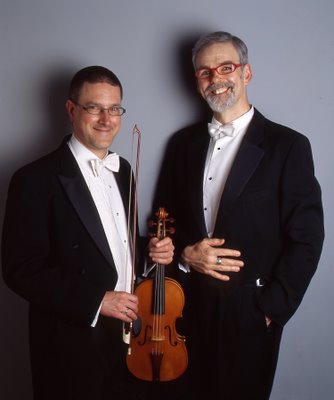
Earlier this evening I atended a concert of the Pacific Baroque Orchestra at St James Anglican on Cordova. I could rant and rave of the surprising Canadian soprano Linda Tsatsanis whose volume filled the church before I could decide that her voice was beautiful and her diction in German flawless. I could rant and rave about our Vancuouver treasure, organist and harpsichordist Michael Jarvis who tackled Jan Pieterzoon Sweelinck’s Fantasia chromatica on the St James 1938 Casavant Frères de St-Hyacinthe pipe organ that was refurbished in 2003. I could rant and rave of enjoying the distinct pleasure of hearing Natalie Mackie play her six- string Violone and know that even though it looks like a double bass it is possibly a member of the guitar family and is sometimes played over handed and sometimes underhanded. I could rant and rave on listening to the violists Jenny Essers and Stephen Creswell and enjoying Ray Nurse’s Theorbo while praying he didn’t hit the long neck with the church’s ceiling.
I won’t rant and rave about the above. I don’t need to. You can see and hear for yourself the same concert tomorrow Saturday at St. Augustine’s in Kitsilano at 8pm or on Sunday at West Vancouver United Church at 2:30. For more info look here. Not mentioned there is the exciting fact that Organist Michael Jarvis says the organ (which he is going to play) at the West Vancouver United Church is one of the most exciting organs in town.
But I will rant and rave of the performance of guest leader and violinist (a Master’s degree in Harvard, no less!) Scott Metcalfe, violinist Paul Luchkow, and of Michael Jarvis (top photograph that's Luchkow and Jarvis) on his lovely scrolled harpsichord, of the Sonata in F for two violins and continuo by Johann Caspar Kerll (1627-93). It is obvious the Metcalfe was taught well on matters of historical performance practice at Harvard as I noticed this succint sentence in the program notes where he describes Bohemian violinist and composer von Biber:
His music imparts something perhaps distinctly Germanic, an earthy delight undergirded by intellectual rigor, conveyed not merely by pyrotechnical figerwork but by captivating virtuosity of rythm, counterpoint and sonority.
I have not had so many shivers going up my spine since I heard Andrew Manze (violin) and Richar Egarr (harpsichord) play the complete violin sonatas of Giovanni Antonio Pandolfi Mealli some years ago at the Metropolitan Tabernacle near City Hall. And it is no coincidence as both Pandolfi and Kerll composed and worked north of the Alps and both lived within the 17th century. The latter in the Italianate court of imperial Vienna and the former in the Hapsburg court at Innsbruck.
To the ears of this rank amateur I found similarities in style, I could hear those wonderful odd (so many centuries before Thelonius Monk was to continue with the tradition in the past 20th century) notes that sounded fresh in their oddness.
Without going into details that I cannot elaborate since I am not a musician, I can only mention that the music of the 17th century was sometimes described as of the “fantastic style”. These composers (many were Italians some in Naples composing under Spanish influence like Andrea Falconieri.) did away with many of the textual constraints and predetermined harmonies of earlier music and often called upon the performer to improvise on the written music. It is as if for a while, in that century, there were no tried and true formulas and experiment was the ruling force.
Going to these concerts of the Pacific Baroque Orchestra one has the excitement of listening to music that has been rarely performed or recorded before. It is like opening a time capsule from the past and listening to new music paradoxically from that past, yet so fresh and new that it is as avant garde today as it was the first time it was performed. I could easily go from one of these concerts to a Turning Point Ensemble concert of new music and the excitement would continue without any necessary rebooting of my brain.
And from my vantage point sitting in the front row I was having a schizophrenic moment trying to decide if I was a Hapsburg prince or a Holy Roman Emperor. These boys and three women were all performing just for me.
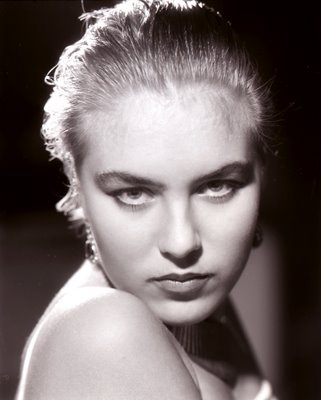
There are many reasons why I am posting Pictures of Sylvie Desroches today. There is even a good reason why I posting two similar pictures of Sylvie Desroches today.
I have photographed my daughters all these years with some regularity. But there was a period when I was uncertain. This was when Hilary was 12 and Ale was 15. I told Rosemary, “I think I am going to ask photographer James La Bounty to photograph our daughters.” “Why?” she asked me and continued, “He is going to be expensive and you are a photographer. What for?" I told her that as their father I would see them as little girls for some time to come, and La Bounty, not being related to the girls would be objective and see them as girls approaching womanhood. He would photograph them as such. Rosemary hated the pictures that La Bounty took. It would seem that she was not prepared, also, to see her girls grown up. After a couple of years Rosemary began to tolerate the pictures that were on our living room wall and a bit later she even told me she liked them. Since then the pictures have been put in storage. That moment of uncertainty between girl and woman is gone. Ale is 40 and Hilary is 37.
But now it is about to return as our Rebecca, Hilary's older daughter, will soon be 12. Next year she is going to Quebec on a school student exchange. And a year later a Quebec girl will stay with Rebecca.
It was when Hilary was 15 that her exchange student came to Vancouver to stay with us. Sylvie Desroches was a lively and sophisticated young girl. At the time I was crazy about classic Hollywood lighting so I asked her if she would pose for me on our living room sofa. I have never really made up my mind if exposure 7 or exposure 8is the better portrait of a 15 year-old going on 20. So I am posting both here.
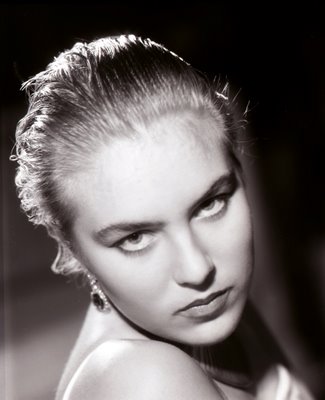
I wonder if Hilary has made any effort to find Sylvie. Perhaps she will become curious when Rebecca travels next year.
And when Rebecca is around 15 how will I photograph her? I am not her father. But as her grandfather will I still see her as a little girl? Or will I see the woman she is bound to become by then? Just another big reason to want to be alive.
Addendum: Rosemary reminded me of a few facts I had forgotten. Hilary and Rebecca, when she was 3, went to Quebec City to visit Sylvie. She was divorced and had a daughter called Margarite. Sylvie had a new boyfriend that she adored. Sylvie's mother was very kind to Rebecca but they could not communicate because they had no language in common. Rebecca called to inform me that Sylvie now lives in Alberta.
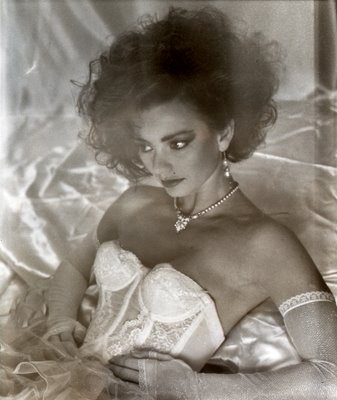
I first met Barbara Rycroft in 1983. It was at the cavernous convention room of the Sands Hotel in Las Vegas. The women dancing on stage were being judged by Tempest Storm. I was taking pictures for McLeans and the Vancouver Province. The women on stage weren’t wearing much. Offstage, Rycroft, dressed to kill, was wearing beautiful slacks, a top with décolletage that would have made the girls on stage blush, and high heel shoes. With kid gloves she was cradling the latest Nikon of the time. Not even all of the Three Graces could have surpassed her style and poise. I felt embarrassed holding my mundane Pentax Spotmatic Fs.

When Barbara Rycroft oozed femininity and sheer elegant sexuality, sexy cars were Pontiacs. Alas we will soon have no more Pontiacs and women like Barbara Hycroft are almost extinct. But the memories remain and somehow that’s comforting.

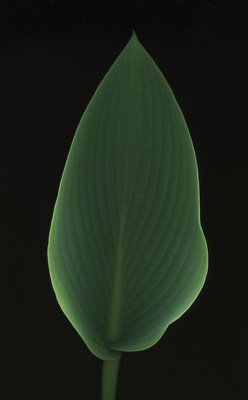
"Manly yes, but I like it too" Irish Spring soap commercial 1970s
At about this time, every year I call up the only other person that I know in Vancouver who shares my love and excitement for the Genus Hosta. Donald Hodgson is a retired school teacher who lives in North Vancouver. He has a backyard wholesale hosta business and he grows only the best of the proven hostas that once established will delight the eye for years during the growing season and come back like clockwork every spring. It was at about this time that Donald Hodgson would say, “I love them now when they are emerging from the ground, the leaves are unfurling and they are pristine. My heart aches at their perfection."
Alas Hodgson, my friend died last year. One of the worst moments of my life happened when his widow Joan called me up to pass by her house and pick some plants. Hodgson was gone and there I was walking on his garden picking plants with a ghost in tow. It was sad yet in some way I felt that by taking some of his plants he would somehow live on in my garden. So many of the best hostas in my garden had already traveled from his garden to mine through the years. Every year he would visit and we would look at each individual plant (I have around 400 of them!) and discuss its merits.
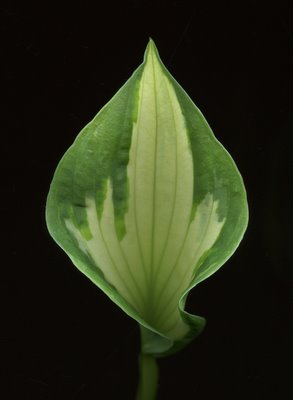
I miss Donald Hodgson. I miss the man with whom I shared my passion for hostas.
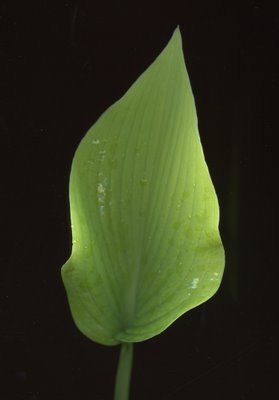
Here are four leaves looking as pristine as Hodgson would Imagine. The bluish one is Hosta ‘Halcyon’. In a month it will become even bluer. In late June Halcyon has many very showy mauve flowers. The variegated leaf is from Hosta ‘Whirlwind’. It is extremely easy to grow in spite of its bold elegance. The third leaf is a “gold” Hosta ‘Marilyn’. She is albescent. This means that as the season progresses the leaves will fade to almost white. The last greenish leaf is simply the underside of Halcyon. If I had to pick the one hosta in my garden that is my steady favourite it would have to be this one.
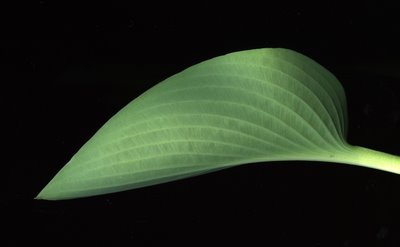
"Fresh and clean as a whistle."
Irish Spring soap commercial 1970s
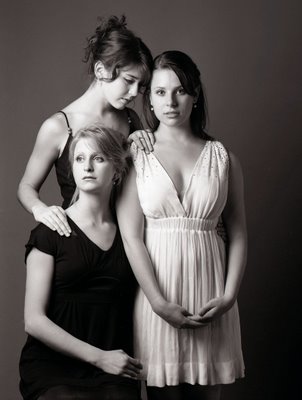
Since Rebecca started taking ballet and dance lessons at the Arts Umbrella in 2004 I have watched the older girls and boys in other classes grow from one year to another. Then in May 2007 I convinced Editor Bob Mercer to run a piece in his magazine, VLM called The Manly Art of Ballet. I wrote of the extraordinary boys who were part of the Arts Umbrella dance program. Around October 2008 I again convinced Bob Mercer (his magazine was floundering by then) that what he needed was youth but with some content. This involved me taking pictures of three young and beautiful girls who were in the Senior Company of the Arts Umbrella Dance Program. But the picture never ran nor did my interview with the three as Mercer ceased publication of his magazine (re-named My Vancouver) in March.
Last Saturday I attended the Arts Umbrella Expressions Festival 2009 that featured the Apprentice Company Dancers (one year behind the Seniors) and the Seniors in one extremely long (three hours) but exhilarating string of performances. Rebecca, Lauren and I managed to sit where we wanted at the Vancouver Playhouse. We sat centre, front row. Our purpose was to be able to hear the dancers breathe.
I had seen these dancers grow up as had Rebecca. Rebecca did not receive all the encouragement she should have at home so she decided to abandon both her dance and her piano lessons. I was able to find a way of saving the latter but not the former. It was my hope that Rebecca would get excited at seeing her ertswhile Arts Umbrella dancers and just might want to return. But this was not to be. Only Lauren (6) is enthusiastic about learning to dance at the Arts Umbrella this fall.
As per usual the performances were top notch, choreographed by noted choreorgraphers D.A. Hoskins, Chengxin Wei (Ballet BC Dancer), Gioconda Barbuto, Roberto Campanella, Joe Laughlin, Francisco Martinez, Sidra Bell, Lina Fitzner (I saw her backstage on Saturday night and she looked absolutely stunning, but then I love red hair), Donald Sales (ex- Ballet BC dancer) and Azure Barton.
All those young girls that I had last seen as the Apprentice Company Dancers, now as the Seniors where to my delight all grown women with bodies to kill for. But I have to confess here that this inveterate Latin man who has always been interested in the female form had his eyes mostly for the boys who were now men. These were the boys I had written about for VLM. Only one was missing, Jeremiah Kennedy (a red head!) who had the best smile of them all. In the picture here Jeremiah is upper right. Upper left is Michel Issa Rubio, bottom left is Jed Duifhuis and bottom right Scott Fowler.

My favourite female dancer, seen in the picture with the four boys is Nina Davies. She had the ambition to join Cirque du Soleil. She was uncommonly flexible. But a year ago she suffered from a back injury so she has not been able to dance since. She is now 18 and her parents are sending her to Europe.
The boy (now a tall young man) on the left, Michel Issa Rubio has a style that is all his own. It is part macho Mexican (he was born in Mexico) and part street fighter/hip-hop. While I am no expert on dance I was able to determine that his style is so personal and unique that he must continue with dance. Bottom right, Jed Duifhuis is very tall and strong and he is a solid partner to the increasingly taller dance girls of our century. I can see him being recruited by all kinds of dance companies. Scott Fowler, bottom left, reminds many of an extremely young Mikhail Baryshnikov. When I last saw him he was a virtuoso little boy. That is no longer the case as he is no longer tiny and has gained meny inches in height. He is but somehow he is not yet a senior dancer. He is much too young to graduate. This means we will have another opportunity to see him next year! The young man I saw perform on Saturday night is what I would call a fenómeno a Spanish word reserved to label all those with unexplained talent.
But from the first moment of the first dance, D.A. Hoskins’ Fruit, my eyes narrowed down the field to watch senior dancer Alex Burton. When I talked to him a couple of years ago he told me that he wanted to be an architect (like his father) and that he loved to explore buildings as spaces for dance. The thought he could combine both professions.
I am sure that one of his mentors at Arts Umbrella, dancer Emily Molnar (on the left with Alex in the middle and Arts Umbrella Dance Director Artemis, Artie, Gordon on the right) would not be surprised in the least as she has repeatedly told me how dancers have intimate knowledge of space and how to work within its boundaries. I am sure that our very own architect, Arthur Erickson would not quibble if we defined that as architecture.
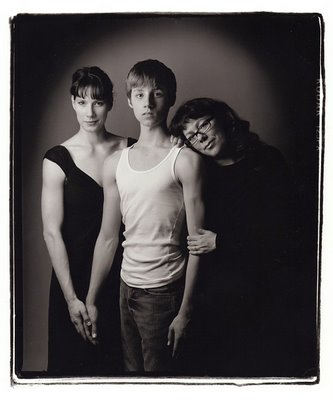
Every time Alex Burton moved on stage I could not look at anybody else. And it was like that for me until the end.
But I did notice the girls and in particular these three in the top picture that would have appeared as the Three Muses in the VLM essay I was going to write. On the top left it’s Alex Parrett, bottom left it’s Alyson Fretz. On the right is Caroline Kirkpatrick. I have a special fondness for both Caroline and Alyson as when they were young girls they were “helpers” in Rebecca’s first ballet class with Andrea Hodge. Rebecca had a tendency to daydream and Caroline or Alyson would set her straight. Again without any much knowledge on dance matters (except I have seen lots of it) I see Caroline as a future choreographer of note. Wherever she goes she is always the centre as she is in my picture. Parrett danced her heart out all night. I would believe that she did not wake up until very late the next day. She was all energy and grace.
For some reasons on the Saturday that we went (there was another performance the day before) there was not all that much of Alyson. But when Alyson was on stage, she was the only one who managed to steer my eyes away from Alex Burton. At last year’s Arts Umbrella program at the Playhouse I watched Alex and Alyson dance together. I don’t remember seeing so much electricity between dancers before. I itch to see them soon in a future performance Prokofiev’s ballet Romeo and Juliet. Where are you John Alleyne when we need you?
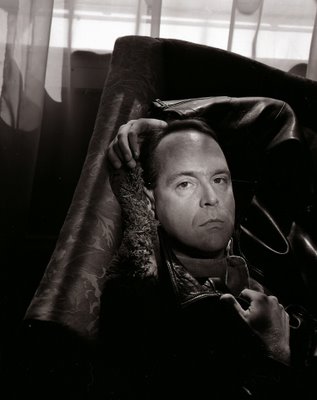
In these last months that I have been teaching photography I have noticed that some of my students (most are quite intelligent) who may be in their early 20s or even 30s have no concept of the former existence of Life Magazine. When I point out to my class (usually an even split beween women and men) that Life’s first cover on November 23, 1936 was taken by a woman, Margaret Bourke-White I am met by blank expressions. I am no longer shocked as I simply think that few now would know of events that happened 73 years ago. At the same time my 11-year-old granddaughter Rebecca can use Microsoft Word with no problems and knows all about different typefaces and font sizes. At age 11 I had no inkling of such things. My students have simply traded knowledge of one thing for another. It is up to me to more or less set them straight on the origins of photography and perhaps this might help them in their pursuit of success in this now difficult medium.
When my Sunday New York Times comes crashing on my doorstep sometime around 7pm on Saturday night I try to ignore it. At one time the paper would arrive much later, much as the daily weekday version does. But the delivery people have become most efficient and I am left with that terrible agony of not wanting to delay the reading of the paper to Sunday morning. Be it Saturday night or early Sunday morning, the first part of the paper I look for is the one titled Week In Review. It will usually have a fine column by Frank Rich and another by Maureen Dowd. The rest is usually extra scrumptious gravy. This is the best section of the paper. Today’s Week In Review visually blasted me with a photograph that had me staring at it for a long time (yesterday it was!). It is a panoramic shaped portrait of retiring American Supreme Court Justice David H. Souter taken when he was attorney general of New Hampshire in the 1970s. The photograph is credited: Ken Williams/Concord Monitor, Via Associated Press.
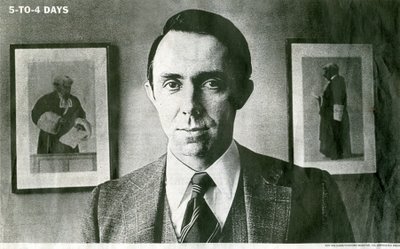
Before I go into my analysis of this striking portrait I would like to point out that the credit for the on-line version is different. It is Jim Cole/Associated Press. This is an interesting discrepancy that has no bearing with my story here. What does have is the fact that there are subtle differences between the look of the hard copy version and the one I see on my monitor.
For years I have received much criticism for taking portraits of people looking at my camera, either most seriously or imagining that they are smiling without in fact doing so. Consider the one here, top left of theatre director Roy Surette, and artistic director of Victoria’s Belfry Theatre. It was American photographer Gregory Heisler who publicly criticized Annie Leibovitz for spoiling it for those photographers who tried to look into the soul of their subjects. Heisler remarked that thanks to Leibovitz now photographers had to photograph people doing something. In some cases this doing had to be an eccentric activity like hanging upside down from a tree or bathing in milk.
This has waned a bit as Leibovitz filed for bankruptcy and Heisler, more or less still relatively unknown, has been vindicated. I wonder what Heisler would say of how portraits are now lit, or in most cases not lit. The advent of the do-everything DSLR (Digital Single Lens Reflex Camera) has made a generation of photographers to so rely on the camera in hand that they don’t consider the possibilities of “tethering” (be it wirelessly or with a cord) the camera to a light and not depending on the light that is available or that pop-up flash that makes it all so easy and, oh so! Flickr.

In the 19th century, before the advent of electrical light portraits, be they photographic, painted or drawn, the rendering of them relied on window lighting or light coming down from large skylights. Such light creates shadows. Shadows give shape to the body and to the face. Shadows hint at the three dimensionality of a person’s face or body on a medium that lacks that third dimension. Flat lighting does away with what in photography is called modeling. Modeling is the contouring of a person’s face with shadows.
What is striking about this portrait of a young David H. Souter is the shading. One side of his face is light the other is dark. The nose somehow (I have never really known how, exactly!) projects an inverted pyramid on his left cheek that those who know call Rembrandt lighting. The absolutely black part of his neck is sharp edged to an area of relative lightness. Again I have never known exactly why except that this is a feature of window lighting or that of a photographic soft box that is placed to one side of a person’s face. The photographer (is it Ken Williams or Jim Cole?) has taken ( I am loathe to use the 2009 term capture) a photograph that shows Souter to be intelligent, urbane and there is, furthermore, just a hint of of a smile. Do either Cole or Williams know of my trick? I tell my subjects, “Think about smiling, very hard, but don’t.”
Colour photographs to this writer are much more effective when there is a lack of colour. A businessman in a dark suit in which the warmth of his skin colour hints that the portrait is in indeed in colour is an example. Contemporary portraiture seems to stress extremely bright, sharp and contrasty colours. This portrait of Souter is the more remarkable in that it has no colour. It is black and white. It stands out in the virtual Babel rainbow of our times.
The discrepancy between the look of the hard copy version, the second picture here and the on-line version, the third picture is due to the manipulation of the scan (this photograph was either a scanned negative or a scanned b+w glossy from a newspaper’s file). The one on my monitor has more of a halo between Souter’s dark side of his head and the back wall. The print version has a more uniform fading into the darkness of the wall. If anything I would like to point out that both images are striking but one might be affected by one over the other without really knowing why. Our ability to subtly change and modify (or not so subtly) the look of a photograph is something that should be considered by all of us and particularly by politicians. Shifting a politician’s face colour from an attractive flesh colour to one that goes into the cyan, the green, or the blue can directly affect our perception of the politician’s qualities and or defects without us being consciously aware.

In the last picture here, a self-portrait by Vancouver Mayor, Gregor Robertson (in my studio, with my camera and facing a large mirror) you can see the modeling on his face, the Rembrandt lighting and that curiously attractive light area right next to the dark side of his face. If I were to up the contrast and open the dark shadows with Photoshop, that area around his head would halo much like in the on-line version of Souter's ever so beautiful portrait.

On Thursday I took Hilary to the SPCA to look for a cat that would replace her Raúl who has gone missing for two weeks. Raúl is 15 years old and he was not well. After seeing a cat she liked (he was an orange cat called Rufus) she said she would wait and have Bruce and the girls see it. Alas this was not to be as when we returned with the girls today Rufus was being put in a carrying box to be taken home.
There was one wonderful moment on Thursday. I took Hilary to Kaplan’s and we had a Montreal smoked meat sandwich which we enjoyed with a black cherry soda. On our way to her house I passed by Montgomery, between 42nd Street and 41st and I had to stop the car. There were trees on that block that I had never seen. They had rugose silver white leaves. One of the trees had been recently planted. It had a tag! The tag read Sorbus aria ‘Lutescens’. A sorbus is commonly called a Mountain Ash which is a member of the very large rose family. While it is called a mountain ash it is not an ash as an ash is from a different genus, Fraxinus.
I could not figure why this variety was called 'Lutescens' as that means yellowish, and I could not see yellow anywhere.
I went home and did some investigation with my tree books. This tree is called a whitebeam and the mysterious yellow is to be found in the down of the silvery young leaves. There is a hint of that in the upper view of the scan seen below left.
The long row of whitebeams on Montgomery was dazzling. They were ghosts that cheered me up. I will have to return to see what the summer white flowers look like. Like many mountain ashes the whitebeam will have clusters of red berries in the fall.

When Rebecca found out that Rufus had been taken she cried. I could not console her. It seems that she has grown up just a bit with the experience while Lauren seem to show no emotion. Perhaps at age 6 she was not aware how quickly Rufus won our hearts and how fate then broke them.
Addendum: I became curious on the closeness between sorbus and sorbitol. The connection is logical. Here it is:
Sorbitol, a sugar substitute also occurs naturally in many stone fruits and berries from trees of the genus sorbus.
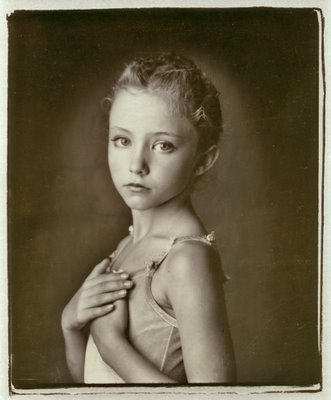
Miss Lydia Louisa Summerhouse Donkins informs Mrs. Cameron that she wishes to sit for her for her photograph. Miss Lydia Louisa Summerhouse Donkins is a carriage person, and therefore, could assure Mrs. Cameron that she would arrive with dress uncrumpled. Should Miss Lydia Louisa Summerhouse Donkins be satisfied with her picture, Miss Lydia Louisa Summerhouse Donkins has a friend who is also a Carriage person who would also wish to have her likeness taken.
I answered Miss Lydia Summerhouse Donkins that Mrs. Cameron, not being a professional photographer, regrets she was not able to ‘take her likeness’ but had Mrs. Cameron been able to do so she would have very much preferred having her dress crumpled.
Julia Margaret Cameron

When I read a novel I never skip the Forewords the Prefaces or in the case of Robert Wilson’s The Ignorance of Blood, the Acknowledgments.
This is the last book in the Javier Falcón Seville Quartet and I would like to take the opportunity to thank the people of Seville for being so understanding at having all this fictional mayhem created in the streets of their beautiful and, comparatively, tranquil city…
My thanks to the brilliant Mr. Ravi Pillai and his assistant, Dr. Hassan Katash, whose surgical skills have kept the Robert Wilson show on the road...
I would perhaps be awfully pessimistic that Wilson’s last Javier Falcón novel (The Blind Man of Seville, The Silent and the Damned, The Hidden Assassins are the previous three) is somehow connected to Mr. Wilson’s health. I suspect that the case may be that he wants to write about other things. After all Wilson has written six other novels that have no connection with Seville and which I enjoyed tremendously. Perhaps Seville (or Sevilla as I prefer to think of it) has taken his Inspector Javier Falcón away from him much in the same way that Alec Guinness took George Smiley away from John Le Carré.
Sevilla can be that possessive. After all, the gold (and silver) of the new world in caravels and galleons went past San Lucar de Barrameda, at the mouth of the Guadalquivir River, a port that concocts its own pale gold, the bone dry manzanilla, and navigated the 80kms to the Puerto de las Indias in Seville. Madrid was just a town.
Spain squandered in Flanders all that gold and silver. But other treasures remained.
There were documents and maps that were housed in Archivo de Indias (The Archive of the Indies). My Manila born uncle, Don Luís Miranda often told me of his trip to Seville to this wonderful place that houses more than 53,000 documents and 8,000 maps and drawings. Accounts in the handwriting of Cortés, Pizarro, Balboa and Magallanes are there. I would suspect that the first maps that gave our new world its name, those drawn by Amerigo Vespucci must be there, too. The place conjures a marvelous world when Spain was its centre.
My first experience with Seville happened in 1985. Rosemary, Ale, Hilary and I stayed at the recently refurbished Alfonso XIII Hotel which was opened by that very king in 1929. Many of the European nobility stayed in the hotel in its glory days as did the best bullfighters that fought at la Plaza de Toros de la Real Maestranza de Caballería de Sevilla and the American author, Hemingway who was writing their story.
Perhaps it was because my daughters spoke English that the staff of the hotel thought we were Americans. They looked at us with stiff disdain and I could think their thoughts, “You Americans are defiling this great hotel that has seen so much Spanish history. Leave us your Dollars and go home.”
As much as I wanted to like Seville, I didn’t. I was tempted. At Santa María Cathedral I gazed on the tomb of Christopher Columbus. I was born in Buenos Aires and until I came to Vancouver October 12th was a holiday, el día de la raza or the day when a new race was born(the spin in those days was that the intermarriage between Spaniards and native Americans produced a superior race, even though mostly the whites, the Spaniards always seemed to be in charge.) Even the tomb was not all that satisfying. It seems the Admiral of the True Oceans’ body was divided a tad and part of his body is in the cathedral in Santo Domingo in the Dominican Republic.

Suffice to say, that Seville has never appealed to my mind but only a bit to my heart. In my heart is that black lace mantilla that my grandmother bought in Seville and always wore to cover her head when she went to Mass. It was with that mantilla that I photographed my oldest daughter Ale.

I fell in love with Seville because Javier Falcon's city, as written by Wilson, somehow became my own. As this Vancouver winter lingers into a cold spring I long for the hot days that Inspector Javier Falcón sweats in, loves in, eats, fights the bureaucracy of the Spanish judicial system and sometimes even drinks. Falcón mentions the heat but never complains.
It was at the bell tower of that Cathedral of Santa María, the Giralda that I also photographed Ale. You can see her at the bottom of the reddish picture. The other photograph is a the Patio de los Naranjos (Courtyard of the Orange Trees) adjacent to the cathedral and seen from the top of La Giralda which projected its shadow into the scene.
Perhaps soon I can return to Seville and see the city through the eyes of that melancholy man, Inspector Javier Falcón. His city would warm my heart.
Burriana, Seville Oranges & Dundee Orange Marmelade
Seville, Oranges, La Giralda, Spooks, Robert Wilson & A Sumo Wrestler
The 1939 Lagonda V-12 Sedanca Coupé & A Proper Sunbeam
Tuesday, May 19, 2009

Last Saturday Rebecca told me,”I want to go to the English car show at VanDusen.” Anything that Rebecca might be interested in that is out of the normal for a girl her age I applaud. Rosemary, Lauren, Rebecca and I went to the show. We were unaware that the show was going to close at 4 when we got there at 3:15. The first cars we looked at were the Morgans. There were 55 of them including three, three wheelers!
Because the show was going to close I told Rebecca, “Let’s go to see the best car here. I knew exactly were to go. I went to the upper area of the garden where they usually display the Lagondas. I was looking for Liz Haan and Bill Holt’s maroon 1939 Lagonda V-12 Sedanca Coupé. This car won the best in its Lagonda Class at Pebble Beach in 1999. It is perfect. Some years ago I had taken my young daughter Ale to see Ed Aveling’s convertible and supercharged Auburn. Ale looked at the car and said, “Daddy why don’t new cars look as new as this one?” If Ale had been with us she would have said the same thing about the maroon Lagonda.

Lagondas are rare cars because few were made. The Holt/Haan Lagonda is especially rare. Consider that it was specially ordered by the King of England in early 1936 and by the time it was delivered to him in New York in 1939 he was the Duke of Windsor. After the war the car exchanged many hands and ended up as property of the wife of a man who owned a North Vancouver car dealership. It was in a terrible condition and it could not be driven.
The maroon Lagonda that Rebecca and I inspected was spotless. We showed interest and in particular I was staring at the beautiful running boards with the chrome strips. Bill Holt came up to us and opened the trunk. He opened a beautiful case lined in green billiard felt. In it was what looked like a brand new tool kit. Holt told us, “I searched through Europe for a year to complete this.” Since Holt is a retired psychiatrist I was not about to question his unusual obsession.

Lagondas are unusual in many ways. The body of the maroon Sedanca is of aluminum laid on an ash chassis. The engine and its racing package was installed in 2 Lagondas (much lighter than this car’s 5000 pounds) that ran in the 1938 Le Mans. I asked Holt if the Duchess would have sat in the back seat. “No, she would have been in the front as the Duke drove the car.” I asked Liz Haan if she ever drove it . “I sometimes do but it is almost impossible for me to park it.” Of course the Lagonda has no power assisted steering.
From the Lagonda Rebecca took me to see a lineup of Sunbeams, Sunbeam Alpines and Sunbeam Tigers. Rebecca was attracted to the plain Sunbeams (not plain at all) and properly called “Proper Sunbeams”! The light blue one you see here has an interesting story. A car exactly like it and in the same colour was driven by Grace Kelly in To Catch A Thief. I did not pursue with Rebecca the Sunbeam Alpine that caught my eye. It was red with a black top. The owner confirmed my suspicions. “Yes it is exactly like the one Elizabeth Taylor drove to her death in Butterfield 8, Daniel Mann’s 1960 film with Lawrence Harvey and Eddie Fisher. The scene where Taylor grinds the heel of her pumps into the front of Harvey’s shoe is a scene that I have never forgotten for its implied pain and eroticism. Rebecca will have to wait a few years before we see that film together.

I do apologize to Bill Holt and Liz Haan for my photographic travesty of their beautiful car. I simply spent too much time on the unusual running boards. Perhaps the next time I just might get a bit more of it. This situation reminded me of one of which I wrote here.
The Whetting Stone & Spotone
Monday, May 18, 2009
whet
/wet/
verb (whetted, whetting) 1 sharpen the blade of (a tool or weapon). 2 excite or stimulate (someone’s desire, interest, or appetite. Origin: Old English.
Compact Oxford English Dictionary

It has only recently that I finally caught on that one whetted one's appetite with that word that included an all-important h. I looked it up today. Coincidentally I was having problems cutting off my damaged rose leaves (the pesky winter moth) yesterday because my Swiss Felco secateurs were not sharp.
When Rosemary and I went to a nursery yesterday I decided I was no longer going to buy a brand new replacement blade for my rose cutters. I paid $22.00 (almost the price of a new blade) for a neat Felco whetting stone. And yes it has that h as it seems the verb has all to do with sharpening either taste or a blade.
Since we began to garden in our Athlone Street house in 1986 we have gone through countless garden tools, lawn sprinklers and a few secateurs. Sooner or later like in almost anything one does, one comes to the realization that the best is almost always the most lasting. Ever few weeks I cannot find my Felco. But I use Rosemary’s trick of remembering where I used it last and I always find. Unless I lose it the Felco secateurs and its whetting stone (made of aluminum oxide) will be the last I will ever buy. If Rosemary wants to she can bury me with them with my hat off to the Texan who was buried with his Cadillac.
When Lauren is excited about some event she always asks Rosemary, "How many sleeps?" Lauren's calendar is made up of days that are separated by her sleeps. In a similar way I ask myself, "Will this be my last Felco?" In a similar vein I have figured that had I not had a little accident a few years ago I would be a Two Spotone Bottle Man. What's that?
The three litle bottles here contain a liquid (Number 1 is a blue black, Number 2 is a sepia and Number 3 is a neutral black) that when applied with a fine brush (there are two here, very dark on the left side) will hide or eliminate the dust marks that appear as white dots on b+w prints, printed on an enlarger. When I was 20 I bought my first set of Spotone. Then about 15 years ago I spilt Number 3 (the most useful colour) and had to buy a bottle. I calculated that the spilt one was the second I had ever bought. A photographer's life span could thus be measured (without an accident) as a two-Number-3-Spotone-bottle life.
The little ceramic tray at the bottom is where I dilute the Spotone gradually by dunking my brush in water and dabbing the indentations. This gives me different degrees of black to a light gray. On the other side (the bottom) I mix my Number 3 in the same way for sepia prints.
For my negative and transparency scans and for the scanned artefacts you see here there is always dust that appears as white little dots on the scan. Spotone does not do the job. I rely on two Photoshop tools. One is called the clone stamp tool and the other the healing brush tool. As Photoshop is constantly being replaced by a new version (mine is plain Photoshop CS) it would seem that it would be next to impossible to be a 3 Spotone Bottle Man in the digital age. I can confidently assert that I will not buy one more bottle of the stuff.
A Blond Vision
Sunday, May 17, 2009

My first cousin Willoughby Blew and his wife Chris visited us from Florida (they are on their way to an Alaska cruise) on Friday evening. Hilary, Lauren and Rebecca were present and Bruce Stewart, who was working, arrived a bit before dessert. We had a “sobremesa” (literally on the table) which is a beautiful word that describes a pleasant conversation after a nice meal. Both Chris and Willougby seem to crave that family sobremesa that we may have observed when all of us were children but were too small to participate.
The original plan was to eat out but in the end we settled for a quick tour of our garden and a relaxed meal at home. It was all so pleasant that it made me think of family more than my usual. As I was looking for those two pictures of Rosemary for yesterday's blog I found this yellowish/green/cyan SX-70 Polaroid. By the window, I know I must have taken this in our Burnaby home between 1975 and 1977. Rosemary is wearing her colorín necklace and she seems to have a band aid in her right hand. Jaime Vidal, a Spanish jeweler and friend in Mexico City not only designed the colorín jewelry set but he also made our wedding rings. They are of gold with an exterior band of fired enamel. Through the years the enamel has chipped off and as our fingers have thickened with age we can no longer wear them. On her left wrist Rosemary is wearing a beautiful jeweled watch that my father gave to my mother. My mother often told me the story that this was the only object given to her by my mother that was left. He had pawned just about everything else to pay for his alcoholic habit. My mother had a talent for breaking watches so she rarely used it except for special occasions. I do remember that the watch mechanism has been repaired a few times. Since Rosemary inderectly inherited from my mother the special talent for breaking watches, she too wears it sparingly.
As I look at this picture of Rosemary where she oozes with elegance and intelligence I can remember the first time I saw her in 1968. She was teaching English at a school where I was teaching. I saw this blond vision (remember I am a Latin!) wearing a very short mini skirt. Her legs rivaled my mother’s in shapeliness. The rest is family history and I would not change any of it.
From This Side Of Death, Deadness Is More Final
Saturday, May 16, 2009

Rosemary says we should be brutal in our family picture filing.
consider the two pictures here. The negatives plus many other pictures I took on the same day are all in negative sleeves. A couple of them from this date (sometime in 1971 in Arboledas, Estado de Mexico) are in our family album. We have three family albums. One incorporates the old pictures of my family beginning around 1878, Rosemary’s picture of her family and then the pictures of us together wich span from the beggining of our relationship to our marriage, Mexico and our drive to Vancouver. There the album stops. Ale, our oldest daughter has an album as well as Hilary and both of theirs also finish in Vancouver. From that point on we live in shoe boxes and a few, the really good ones in pewter frames on our piano or framed on the wall. But the negatives and slides are all carefully filed under years in my multiple metal cabinet filing system.
Rosemary says we should pick one or two of a session and throw the rest away. I am not sure she is right. On the other hand there is a tintype of some late/middle 19th century relatives of Rosemary. She has no idea who they are. At that point we could throw it away (except for the intrinsic value of the original tintype it is). I feel that after about 100 years (and that span is getting compressed) most of us lose sight and memory of old pictures. In a not too far future, pictures in CDs might not be viewable and even if they are who will know who the people in them are?
Is it worth filing family pictures as Rosemary and I are? When we both go will our daughters chuck them into the Straight of Georgia or burn them in a fireplace? Does it matter?

As it stands here are two that I placed in our album long ago and even then I was undecided which one was the better one so I put both in. I cringe at the idea that we wore his and her identical shirts. I remember that we both wore white jeans and had some white leather high top shoes with a rubber sole that was about four inches thick. I also remember that I was the one who helped Rosemary pluck her eyebrows!
The “art work” behind I made out of lacquered wood mounted on clear Lucite. The colours were white; the bottom bar was orange and the vertical one red. I used very expensive car lacquer and I sprayed it on with a little hinged double-tube mechanism that I used to fix the pastels I made many years before when I painted and had yet to buy a camera. It was my 1970 attempt at modern art.
It is sobering to understand that my archivaly processed prints from which I scanned the images you see here will, if they survive a dunking in the Straight of Georgia or a fire, will perhaps be seen by a descendant who will stare at us, not know who we are and just throw them out. Just like perfect cannot be made more perfect, our deadness will not be more so. But from this side of death it seems even much more final.
Donde El Rey Va Solo
Friday, May 15, 2009

One of my earliest memories as a child is the bathroom. It was a large bathroom in our Buenos Aires house on Melián Street. It was a very old house shaped like an L. The short part of the L connected to the main house (living room, dining room and my parent’s bedroom began with our kitchen and beyond it was the bathroom. Since the kitchen with it old black gas stove was the warmest room in the winter I can see why the bathroom would be right next to it. It had a bidet. I did not have any idea of its purpose except at least twice I played with it and a very high pressure jet of water hit the ceiling and destroyed the plaster. I have no memory of the toilet or ever sitting on it. It could have something to do with the fact that children in school and as late as a conscript in the Argentine navy I was called Watercló. The English had left their mark in Argentina with their futbol, their tramways, trains and waterclosets. In an attempt at independent sophistication Argentines had their very English tea at Frenchified Salons de Thé.
I remember being in the tub and watching my mother using an eyecup. It was a strange sort of semicircular glass device with which she cleansed or rinsed her eyes. She would look down into the device and then throw her head back. I was convinced that my mother could pop her eyeball in the cup and wash it all around.

I may have been around 8 when I began to read Pato Donald comics in the tub and discovered the only two really good places to read which is the tub and one’s bed. The toilet should never be used for reading pleasure. It is best used to rid oneself of constipation by sitting down with something very difficult to read. The distraction and concentration of reading loosens up the works.
The tub or the shower is a godsend for the gardener particular this one. I never use gloves. After a few hours of digging and putting my hands in dirt or mixing the manure with compost, my finger nails get filthy. This is when washing one’s hair is most useful. I have several good nail brushes, including a fine nylon one from Lee Valley Tools but none of them work as well in cleaning under my fingernails as washing my hair vigorously with a shampoo.
It was my Manila-born uncle, Don Luís Miranda who always seemed to have more fun than anyone else in the bathroom. He liked to work on the New York Times crossword puzzle “en donde el rey va solo” (where the king goes alone) and he was a legend in our family for singing Gilbert & Sullivan or Puccini while showering. He sang complete arias while showering. He was thorough in his bathing procedure. This was the man who had once told me that he hated going to the beach because sand got into his shoes.

He would have been shocked to find out that I have a fondness for cold breakfast pizza in the tub. As summer approaches I know there will be some special afternoons where the sun will be just right and fracture light as it goes through our glass bathroom door knob. Rosemary prohibited me from hanging towels (especially wet ones) behind the bathroom door as in the picture here. She says that the nice white paint will peel. Luckily I took this picture. I had filed it away and discovered it yesterday. That’s Mark Budgen’s friend Aja (pronounced Asia) in Mark Budgen’s tub. I may have taken that picture about 15 years ago.
1986 Was A Good Year For Snaps & Growing Hedges
Thursday, May 14, 2009

Of late Rosemary and I have been filing our family pictures. Until Rebecca was born 11 years ago our files were loose in groups called "early 70s" or "early 80s". But as soon are Rebecca came along and then Lauren I began to take so many pictures that we have now filed them under spicific years. As we file we find pictures that I took that I forgot I took, or I simply never had the time or inclination to go down to the basement to my darkroom to print. Some of those pictures are a revelation and a joy to me.
In 1986 business was good for me. I was working for tons of magazines and there were tons of business magazines across Canada. I was working for all of them. My shrewd wife decided we should move from our comfortable townhouse in Burnaby that had a little garden. “I want to live in a nice house with a real garden,” she told me. She made us move to our present location on Athlone Street in Kerrisdale in 1986. In 1986 I was yet to be jaded by the idea that I should only take pictures for money. So I took quite a few pictures of my daughters Hilary and Ale. The picture of our house shows it in a very early stage when we still had not worked on the garden. We were completely ignorant. Ale had a boyfriend who had a farm in Ladner. He brought us a pile of horse manure one day. I actually, in complete ignorance, manured the laurel hedge you see here not knowing he work that lay ahead to prune it. That hedge wraps around on the right and goes halfway down the boulevard. As my Spanish grandmother would have said, “Ignorance is daring.”

The picture of Hilary (in b+w) has her on the wooden floor of the living room. Next to her was our first Canadian cat, Gaticuchi. Hilary looks beautiful and relaxed. I photographed Ale in Hawaii. We seemed to have some extra money to travel there.

The two girls are gone. Many of the conifers in the picture died of root rot and old age. One thing has not changed. Even though I am now smart enough to never fertilize that laurel hedge, it grows! I will have to tackle it in about a week and it will take about three days using hand sheers. Electric hedge clippers leave a mess as the laurel hedge’s branches are tough and the cuts are not true. The result is messy. I hate the job but I don’t think I would want to return to Burnaby. Rosemary has always been right.

From The Left & From The Right
Wednesday, May 13, 2009

Warning! What is below could be seen as a mild political rant. Do not proceed unless you are partial to rants from citizen/amateur nonentities.
A day after our provincial elections I was lucky to find a photograph sent to me by writer Kerry McPHedran in 1986. The photo, taken by Glen Erikson is of your blogger with the founder and editor of Equity Magazine, Harvey Southam. I have written about Southam before here. But I simply had not pictures of him. He asked me to photograph his mother, his wife and even one of his children but I never pointed my camera at him.
When I went to his memorial service (he died by his own hand in 1992) at Christ Church Cathedral I went for one single reason. I wanted to be present at a place that I thought would represent an end of era. Most of those in the church were white and the minister spoke of summer holidays at the Southam house in Qualicum. Even today a visit to Qualicum is a visit to what now seems to be an uncomplicated past.
There are some of my friends who did not get along with Southam. There are some who say he was nasty to them. I never saw that side of the man. He was always kind and pleasant to me and he indulged me when I wanted to take unconventional photographs for his business magazine. With Southam I met the real decision makers of our city and province. He had access to all of them.
An event in 1991 should have given me an indication of things to come. NDP MLA candidate David Schreck defeated Liberal Floyd Sully in North Vancouver-Lonsdale. In 1992 the Liberals were liberals in the real meaning of the word. Few now will remember or realize that the BC Liberals are really a re-named Social Credit Party. Our Provincial Liberal Party is a conservative party but few will point that out.
I had an admiration for Southam because as a man who had all to gain by keeping the establishment as it was, he had a couple of columnists write on the same theme every month. On the left page was Floyd Sully’s From the Left and on the right there was From the Right with George Froehlich. I do not remember the name of the conservative writer. In those years, the late 80s I would turn to Vancouver Magazine’s last page to read Sean Rossiter’s 12th and Cambie. It was all about city politics but also of subjects dealing, as an example, the engineer who was designing left turn bays at traffic lights or what it was like to check in at the venereal disease clinic. From Vancouver Magazine I would then go to Equity and read From the Left and From the Right. It was always entertaining.
It was also Southam who started the strings of articles that eventually did in the Vancouver Stock Exchange. He hired Adrian du Plessis to write a cover article on the dubious shenanigans of the exchange.

Southam was a man of his times. When I told him that Alderman Bill Yee would make an excellent ethnic city mayor he told me, “Not while I am around.”
A few weeks before he died in 1992 I went to Toronto to look for work with national magazines. I called up Southam’s company around 6 in the afternoon. He answered the phone. We had a couple of cokes near his office and he was as gracious as ever with me.
As I look back to the man, I realize that journalism’s strict sense of ethics has been in a decline. It was only three or four weeks ago that an “entertainment/arts” article in our local big daily had an article in which the executive director of a theatre company interviewed a theatrical director of the company. There was no byline and no explanation. Most of those who are under 30 would perhaps not catch the lapse in journalistic ethics. I have heard rumours of other publications that strongly suggest that buying an ad will guarantee editorial content. Times are tough but there is such a thing as right and wrong. Southam knew that difference and his magazine, gone all these years, looks better and better to me.
When our Liberals are really conservatives how is a voter supposed to know how to vote? A solution is to distance oneself from the “center/right/from left/ but not so much to the left as to the right of the centre” and to clearly call a spade a spade. The NDP could do worse than:
1. A gutsy renaming of the party to the NLP (New Left Party)
2. A milder renaming to The Canadian Democratic Party or CDP. There is absolutely nothing new about that N in the NDP.
With the Commies now the most avaricious and nasty capitalists (we are living the new Dickensian times), what is wrong with being from the left? There is a newness there!
Equity art director, Randy C Pearsall did not want to have any problems with the police. We did not paint the nearby wall to the Vancouver Stock Exchange. He had some transfers made. He carefully stuck them on the wall, I took the picture and we left with no incident.
I Conversed With You In A Dream
Tuesday, May 12, 2009
I consider myself to be both priviledged list and extremely lucky to get the occasional invitation to watch a choreographer's work in progress. It is interesting to see the beginning and intermediate steps (in some cases raw steps) that lead to a finished and polished choreographic work. These works in progress come with explanations, reasons and what inspired them. In the case below choreographer Simone Orlando's talk (she was elegantly dressed to kill!) was preceded by high praise from Ballet BC Artistic Director John Alleyne who also explained how the grant in question works. There was an additional surprise. Her name is Jocelyn Morlock.

Dear Ballet BC Supporter,
You are invited to attend a FREE, informal showing of a new work by Ballet BC member and choreographer Simone Orlando created through a Fellowship Initiative Grant from the New York Choreographic Institute.
The process, which began on April 20, culminates with this post-work presentation at the Scotiabank Dance Centre on Monday evening. This innovative new work features Ballet BC company dancers Makaila Wallace, Jones Henry, Connor Gnam, Maggie Forgeron, and Leon Feizo-Gas.
WHEN: MONDAY, MAY 11, 2009 @ 5:30pm
WHERE: SCOTIABANK DANCE CENTRE - THE FARIS STUDIO
677 Davie Street Vancouver
This is an open-invitation event, so please feel free to bring and invite friends.
"Ballet BC has been awarded a Fellowship Initiative grant from the New York Choreographic Institute, an affiliate of New York City Ballet, to support the development of new choreography in a studio setting. The choreographer will be Simone Orlando. Peter Martins, Founder and Artistic Director of the Institute states: 'The Fellowship is meant to help ballet companies to create an environment in which a choreographer can develop ideas without the pressure of stage production. The Institute is committed to classical choreographers who will be creating works for the future."
Lauren, Rebecca and I arrived early so that we could sit up front centre. At the Farris Studio this means that your feet are on the dance floor. Rebecca no longer has to explain to anybody, as I do, that we like to hear dancer's gasp for air and see the sweat on their bodies. We did manage to sit in that front row but not before I greeted young Vancouver new music composer Jocelyn Morlock. I could not figure out why she was there. Then I spotted trombonist and co-director of the Turning Point Ensemble, Jeremy Berkman and in another area of the studio composer Owen Underhill who is the musical director of the Turning Point Ensemble. I was intrigued. Lauren was dead serious staring at the five Ballet BC dancers who were warming up (one of the nice extras of being in a work-in-progress situation).

Simone Orlando, above centre, set us straight when she mentioned that her ballet was based on two pieces of music. One was Antonin Dvorak's Piano Trio in E Minor, Op 90 "Dumky" (1891) and the other (aha!) Jocelyn Morlock's I Conversed With You In A Dream. Morlock's work is inspired by Sappho's fragmentary poems. It is a duo for flute and piano. The version we heard was with pianist Rachel Iwaasa and flutist Mark McGregor, below right.

The Dvorak piece had lots of classical ballet which contrasted so nicely with Morlock's music as Orlando incorporated more modern ballet into her dancer's movements. Complicating matters rather nicely, Orlando could only use five dancers, so many of them (in a work full of Greek gods and godesses) played more than one god. Jones Henry seen here with Rebecca and Lauren played both Zeus and Hephaestus (god of fire and especially the blacksmith's fire).
My girls behaved. The afternoon was most pleasant. My only regret, while watching
dancer Makaila Wallace, was to wonder why I have never had the opportunity to photograph her. She is Vancouver's epitome of the classical ballerina (but so sumptuously well shaped, nonetheless!) now that Andrea Hodge has retired from active dancing.
Cocktails For Three & Bananas At The Dinner Table Part II
Monday, May 11, 2009

My godmother and first cousin, Inesita O'Reilly Kuker has been in my thoughts of late. I wrote most recently about her here.
She has been in my thoughts for several reasons. One of them is that she did get the audio book I sent her mentioned in the above link. She was delighted and it seems she has listened to the book twice.
The whole odyssey of trying to solve my godmother's reading problem began a few months ago when she went on a vacation to her apartment in Punta del Este, Uruguay. She returned and soon after her son Georgito arrived to pick her up to take her for a weekend family gathering. He was shocked. Her face was all black and blue and her eyes were bloodshot. The independent soul that Inesita (she is 85) is prevented her from telling anybody that she had fallen in Uruguay. Her son took her to see a doctor who confirmed that she had a blood spill in her eyes. He injected her eyes and told her it would take at least 6 months to regain her full vision.
Most of my other cousins told me I should mind my own business and that Inesita did not need to read. It would seem that even though they live in the same city with her (Buenos Aires) they don't know how important reading can be for someone, or how important it is to read in one's chosen language. One of my cousins told me to get her a subscription to a large print Reader's Digest. For once diplomacy ruled and I did not bother to tell her that Inesita would never read Reader's Digest in any form be it small or large print.
As I have often written here Inesita would have been categorized by my mother as "gente fina". It is as difficult to translate as the Spanish word educación. The primary meaning of this word is a combination of well-mannered/good upbringing and poise. Gente fina adds to the mix a bit of knowledge of the arts and the person would have to be well read. Inesita, as gente fina would never acknowledge liking or reading the Reader's Digest. And that was exactly the case when I told her, jokingly, that I might get her that subscription. "Don't even think of it."
In Vancouver I admire those in the modern and ballet dance community because I can say with almost no exception that the majority that I have met have this poise, this presence that my mother so often told me was a rare thing. I would have liked my mother to notice that I am trying to make Rebecca and Lauren, gente fina. So we go to dance and theatre and I coach them on table manners!
Today I went to the main post office and mailed Pride and Prejudice read by Jenny Agutter, Daphne Du Maurier's Jamaica Inn read by Samantha Bond (Pierce Brosnan's Miss Moneypenny) and Angela’s Ashes read by the author, Frank McCourt. I wish I could be there when they get to her.
The other reason that I have been thinking of Inesita is that this Friday I will have Willoughby Blew and his wife Chris for dinner. They live in Florida and they are going on an Alaska Cruise. Willoughby Blew is my first cousin. As a young man in the Argentine navy I had a crush on his sister Elizabeth. Rebecca has met my three Buenos Aires cousins, Inesita, Diane and Elizabeth. With Willoughby the list will be complete (there were four more but they died) and when she grows up she might remember enough to keep our family story going.
I told Willoughby I was going to make a cheese fondue. This was his reply:
Dear George,
As you can well imagine we are in your hands when it comes down to deciding where to eat in Vancouver. Either the restaurant (Next) you recommend or the fondue dinner at your home are fine with us and we will leave the final decision up to you. Whatever is easiest and best for all is OK with us.
I'm assuming your fondue is made with equal parts of Gruyere, Ementhaler and Appenzeller cheeses complemented with Neuchatel wine, kirsch, black pepper, nutmeg and garlic. I remember eating cheese fondue practically on a daily basis when I lived in Zurich back in 1969. I just could not get enough of it.
How on earth do you know it will be a rainy day in Vancouver on Friday, May 15? I know that the law of probabilities says it will probably rain but then "the exception makes the rule".
Willoughby
Rosemary is in a bit of a panic as she thinks Willoughby is some sort of perfectionist. Consider what he said of the wine I was planning to serve:
Dear George,
The Hayward "bug" is among us but has never deprived me from enjoying a good glass of wine. Moderation is the word.
The taste of "green grapes" you refer to when you drink a Torrontés is exactly what makes this wine similar to a Gewutztraminer from Alsace. Some people love this flavour and some hate it.
Bodegas Etchart, also from Cafayate, Salta makes a very good Torrontés called "Etchart Privado". I have not seen this wine in the US for some time now. This may be the "reserva Especial" you referred to.
Given that you will drink wine in moderation if it is a Torrontes and given that we have now settled on having your famed fondue would you like me to bring a couple of bottles of whatever Torrontés is available at your local Government store.? A simple yes or no will do.
Manzanilla of course is a sherry and therefore somewhat higher in alcohol than most still wines. I was rather shocked to read (three times) that you pour your half bottle of San Lucar de Barrameda Manzanilla into a soup bowl to drink. Most folks find that a small glass of this sherry makes for a good aperitif. I have never heard of anyone drinking it by the bowlful but then, cada loco con su tema. So much for the Hayward "bug".
Rosemary's Pavlova with dulce de leche sounds wonderful and dietetic to boot.
We are also looking forward to our reunion.
Willoughby
Because I insist in calling Willoughby by his middle name, James, he calls me by my first name, George. I look forward to our family dinner. One of the toasts will surely be to another "gente fina" and that's Inesita our first cousin.
Roksana - The James Bond Girl
Sunday, May 10, 2009

I have not always succeeded in maintaining a distance with my students but I try very hard. At the two schools where I teach photography, Focal Point and Van Art I tell my students that if they want to communicate with me they can forward me e-mails through the administrator of the photography department. Only last week a female student asked me if she could address me as “Sir Alex”.
In years past phone numbers were either more difficult to get or easier. Most people were in the phone book unless the number was unlisted. Now, with many having cellular phones, that phone number is hard to get. But if one has a web page (and I have one) my students can find either my phone or a method of e-mail communication called contact submission.
I would further define our age of instant communication as an age of quick intimacy. I blog and in it I write personal stuff. Students call me Alex instead of Mr. Hayward. For years in Mexico I addressed my students as Mr. or Miss. This idea is pretty well gone unless you are in a Canadian Armed forces boot camp.
So I had to give it much thought when a part-time student (over 20) waited until the last class to ask me if I would photograph her. I run photography as a business and I cannot reject work simply because I might have an over-sensitive concept of what a teacher student relationship should be. Technically when she came to my studio she was no longer my student.

Roksana was Polish and lived in London. She was a banker. She sat in the front row of my photography class and I don’t think she ever wore the same pair of exquisite shoes twice. In my mind she was a James Bond girl. She looked like a James Bond girl, she dressed to kill and seemed to live a jet set life (I define here jet set in the old term when flying was exciting and sexy). To top it all she was a good photographer.
Mayfair & Memories Of Another
Saturday, May 09, 2009

When Rebecca arrived at noon today for her piano lesson (we have a Chickering baby grand in our living room so her classes are here) she said, “I want to go to Mayfair.” Mayfair in our neck of the woods is the annual fair held at the nearby Catholic private school Vancouver College. There was no way I was not going to please Rebecca and Lauren (she also wanted to go) on this wish. Sometimes I rent a movie but it seemed a shame to stay inside on a beautiful day like the day today was. So Rosemary and I took the kids to Mayfair. I strapped a couple of Nikon FM-2s around my desk. “You look like a tourist!” Rebecca said. I countered, “With these film cameras I don’t look like a tourist, I look like an old man.” I joked with Rebecca that the reason she wanted to go was to ogle the handsome private school boys. This did not seem to be the case. “I want to go on the bungee cord jump.” Lauren said, “And I want to go into the Pirate Ship.” It seemed harmless enough. We walked.
It was a bit of letdown as memories flashed in my head of fairs in the American or English schools in Buenos Aires and in Mexico. They had all kinds of treasures, Mickey Mouse comic books in English (can you imagine that!) and later in the 50s used Tom Corbett Space Cadet or Hardy Boys mystery books.
At the Mayfair they had boring games (the exception was the bungee cord for which Rebecca waited close to 40 minutes on a long queue) and lots of food. The gym was full of junk by the time we got there mid afternoon. But Rebecca enjoyed her three minutes on the bungee cord jump and while she made several back flips she refused to make any front ones. Not having a digital camera I have no idea what my pictures will look like.

Back home I instructed Rebecca to write in a notebook the location and state of every rose in the garden. If the rose was missing a tag, Rebecca printed out its name in her very neat writing. The purpose of the exercise was to prepare her for our joint appearance in the forthcoming World Rose Convention in Vancouver in late June. Our lecture is called A Rose Through a Child’s Eyes. Rebecca has to learn more about roses. During our work she said, “This is like studying except it is fun.” Part of her job was to assess the condition of the rose bush and to mention if it had scent, how powerful that scent was and if it was fruity or myrrh, not to mention the colour and shape of the flowers. We finished our day with barbecued chicken, white rice and sliced ripe tomatoes. After our meal Hilary surprised us with a DVD called Miss Potter which we all enjoyed. Taking them home I was again hit by waves of memories of those former fairs and of one in particular in 1951.

That year my mother was teaching at the American High School. I was going to the nearby (two blocks) American Grammar School. Only in recent years have I finally come to understand that I never ever went one day to a public school and that my mother always found ways of sending me to private schools. She must have had a deal that by teaching at the high school (she was loved and appreciated and the school annual for 1951, The Southern Star is dedicated to her) I did not pay to go to what must have been an expensive school.
As soon as I got home I went to the family album in search of a picture that I remember was taken that year at the school fair. In Spanish we called it a tombola. In back of the picture here (my mother is in the middle with the funny hat) it says barrel pull. I think it may have been filled with sand or saw dust and the little boys in the picture bought tickets to then take their chances of finding “valuable” prizes.

Perhaps they didn’t have the exciting games they had at Mayfair but through a child’s eyes it must have been every bit as exciting. At Mayfair I noticed lots of 14 year-old girls with great big fronts of metal in their mouths trying not to notice the boys that were trying not to notice them. At age 9 it must have all gone over my head in that fine afternoon at the American School in Buenos Aires.

I noticed that the Southern Star's editorial began like this:
The world today is challenged by two great powers, Democracy and Communism. The outcome of present and future conflicts will determine a new phase of history. Which of these is for the best is for each one of us to decide.
When you consider that the modest sized school annual had lots of ads as end pages including this one by General Motors you know in which direction the school was rooting for.
Dieterich Buxtehude & The Boys
Friday, May 08, 2009
The Boys being composers (all living in 17th century Germany, Holland and Denmark) Heinrich Ignaz Franz von Biber, Christoph Bernhard, Johann Heinrich Schmelzer, Jan Pieterszoon Sweelinck, Franz Tunder, Johann Caspar Kerll, John Jacob Froberger.
I am not ashamed to admit that I have only heard of three of the above men. And I have even listened to some of their music, in particular the pleasantly depressing Lamento sopra la morte Fedinandi III by Schmelzer (c.1620-80), courtesy of past concerts of the Pacific Baroque Orchestra and Early Music Vancouver. I am not ashamed as the Pacific Baroque Orchestra seems to have taken the mandate to boldly go. And this is refreshing. No more chestnuts, most of their concerts are surprises into uncharted territory.

Earlier this evening I atended a concert of the Pacific Baroque Orchestra at St James Anglican on Cordova. I could rant and rave of the surprising Canadian soprano Linda Tsatsanis whose volume filled the church before I could decide that her voice was beautiful and her diction in German flawless. I could rant and rave about our Vancuouver treasure, organist and harpsichordist Michael Jarvis who tackled Jan Pieterzoon Sweelinck’s Fantasia chromatica on the St James 1938 Casavant Frères de St-Hyacinthe pipe organ that was refurbished in 2003. I could rant and rave of enjoying the distinct pleasure of hearing Natalie Mackie play her six- string Violone and know that even though it looks like a double bass it is possibly a member of the guitar family and is sometimes played over handed and sometimes underhanded. I could rant and rave on listening to the violists Jenny Essers and Stephen Creswell and enjoying Ray Nurse’s Theorbo while praying he didn’t hit the long neck with the church’s ceiling.
I won’t rant and rave about the above. I don’t need to. You can see and hear for yourself the same concert tomorrow Saturday at St. Augustine’s in Kitsilano at 8pm or on Sunday at West Vancouver United Church at 2:30. For more info look here. Not mentioned there is the exciting fact that Organist Michael Jarvis says the organ (which he is going to play) at the West Vancouver United Church is one of the most exciting organs in town.
But I will rant and rave of the performance of guest leader and violinist (a Master’s degree in Harvard, no less!) Scott Metcalfe, violinist Paul Luchkow, and of Michael Jarvis (top photograph that's Luchkow and Jarvis) on his lovely scrolled harpsichord, of the Sonata in F for two violins and continuo by Johann Caspar Kerll (1627-93). It is obvious the Metcalfe was taught well on matters of historical performance practice at Harvard as I noticed this succint sentence in the program notes where he describes Bohemian violinist and composer von Biber:
His music imparts something perhaps distinctly Germanic, an earthy delight undergirded by intellectual rigor, conveyed not merely by pyrotechnical figerwork but by captivating virtuosity of rythm, counterpoint and sonority.
I have not had so many shivers going up my spine since I heard Andrew Manze (violin) and Richar Egarr (harpsichord) play the complete violin sonatas of Giovanni Antonio Pandolfi Mealli some years ago at the Metropolitan Tabernacle near City Hall. And it is no coincidence as both Pandolfi and Kerll composed and worked north of the Alps and both lived within the 17th century. The latter in the Italianate court of imperial Vienna and the former in the Hapsburg court at Innsbruck.
To the ears of this rank amateur I found similarities in style, I could hear those wonderful odd (so many centuries before Thelonius Monk was to continue with the tradition in the past 20th century) notes that sounded fresh in their oddness.
Without going into details that I cannot elaborate since I am not a musician, I can only mention that the music of the 17th century was sometimes described as of the “fantastic style”. These composers (many were Italians some in Naples composing under Spanish influence like Andrea Falconieri.) did away with many of the textual constraints and predetermined harmonies of earlier music and often called upon the performer to improvise on the written music. It is as if for a while, in that century, there were no tried and true formulas and experiment was the ruling force.
Going to these concerts of the Pacific Baroque Orchestra one has the excitement of listening to music that has been rarely performed or recorded before. It is like opening a time capsule from the past and listening to new music paradoxically from that past, yet so fresh and new that it is as avant garde today as it was the first time it was performed. I could easily go from one of these concerts to a Turning Point Ensemble concert of new music and the excitement would continue without any necessary rebooting of my brain.
And from my vantage point sitting in the front row I was having a schizophrenic moment trying to decide if I was a Hapsburg prince or a Holy Roman Emperor. These boys and three women were all performing just for me.
Sylvie Desroches - Girl/Woman
Thursday, May 07, 2009

There are many reasons why I am posting Pictures of Sylvie Desroches today. There is even a good reason why I posting two similar pictures of Sylvie Desroches today.
I have photographed my daughters all these years with some regularity. But there was a period when I was uncertain. This was when Hilary was 12 and Ale was 15. I told Rosemary, “I think I am going to ask photographer James La Bounty to photograph our daughters.” “Why?” she asked me and continued, “He is going to be expensive and you are a photographer. What for?" I told her that as their father I would see them as little girls for some time to come, and La Bounty, not being related to the girls would be objective and see them as girls approaching womanhood. He would photograph them as such. Rosemary hated the pictures that La Bounty took. It would seem that she was not prepared, also, to see her girls grown up. After a couple of years Rosemary began to tolerate the pictures that were on our living room wall and a bit later she even told me she liked them. Since then the pictures have been put in storage. That moment of uncertainty between girl and woman is gone. Ale is 40 and Hilary is 37.
But now it is about to return as our Rebecca, Hilary's older daughter, will soon be 12. Next year she is going to Quebec on a school student exchange. And a year later a Quebec girl will stay with Rebecca.
It was when Hilary was 15 that her exchange student came to Vancouver to stay with us. Sylvie Desroches was a lively and sophisticated young girl. At the time I was crazy about classic Hollywood lighting so I asked her if she would pose for me on our living room sofa. I have never really made up my mind if exposure 7 or exposure 8is the better portrait of a 15 year-old going on 20. So I am posting both here.

I wonder if Hilary has made any effort to find Sylvie. Perhaps she will become curious when Rebecca travels next year.
And when Rebecca is around 15 how will I photograph her? I am not her father. But as her grandfather will I still see her as a little girl? Or will I see the woman she is bound to become by then? Just another big reason to want to be alive.
Addendum: Rosemary reminded me of a few facts I had forgotten. Hilary and Rebecca, when she was 3, went to Quebec City to visit Sylvie. She was divorced and had a daughter called Margarite. Sylvie had a new boyfriend that she adored. Sylvie's mother was very kind to Rebecca but they could not communicate because they had no language in common. Rebecca called to inform me that Sylvie now lives in Alberta.
When Women Were Women & Cars Were Pontiacs
Wednesday, May 06, 2009

I first met Barbara Rycroft in 1983. It was at the cavernous convention room of the Sands Hotel in Las Vegas. The women dancing on stage were being judged by Tempest Storm. I was taking pictures for McLeans and the Vancouver Province. The women on stage weren’t wearing much. Offstage, Rycroft, dressed to kill, was wearing beautiful slacks, a top with décolletage that would have made the girls on stage blush, and high heel shoes. With kid gloves she was cradling the latest Nikon of the time. Not even all of the Three Graces could have surpassed her style and poise. I felt embarrassed holding my mundane Pentax Spotmatic Fs.

When Barbara Rycroft oozed femininity and sheer elegant sexuality, sexy cars were Pontiacs. Alas we will soon have no more Pontiacs and women like Barbara Hycroft are almost extinct. But the memories remain and somehow that’s comforting.

A Halcyon Irish Spring
Tuesday, May 05, 2009

"Manly yes, but I like it too" Irish Spring soap commercial 1970s
At about this time, every year I call up the only other person that I know in Vancouver who shares my love and excitement for the Genus Hosta. Donald Hodgson is a retired school teacher who lives in North Vancouver. He has a backyard wholesale hosta business and he grows only the best of the proven hostas that once established will delight the eye for years during the growing season and come back like clockwork every spring. It was at about this time that Donald Hodgson would say, “I love them now when they are emerging from the ground, the leaves are unfurling and they are pristine. My heart aches at their perfection."
Alas Hodgson, my friend died last year. One of the worst moments of my life happened when his widow Joan called me up to pass by her house and pick some plants. Hodgson was gone and there I was walking on his garden picking plants with a ghost in tow. It was sad yet in some way I felt that by taking some of his plants he would somehow live on in my garden. So many of the best hostas in my garden had already traveled from his garden to mine through the years. Every year he would visit and we would look at each individual plant (I have around 400 of them!) and discuss its merits.

I miss Donald Hodgson. I miss the man with whom I shared my passion for hostas.

Here are four leaves looking as pristine as Hodgson would Imagine. The bluish one is Hosta ‘Halcyon’. In a month it will become even bluer. In late June Halcyon has many very showy mauve flowers. The variegated leaf is from Hosta ‘Whirlwind’. It is extremely easy to grow in spite of its bold elegance. The third leaf is a “gold” Hosta ‘Marilyn’. She is albescent. This means that as the season progresses the leaves will fade to almost white. The last greenish leaf is simply the underside of Halcyon. If I had to pick the one hosta in my garden that is my steady favourite it would have to be this one.

"Fresh and clean as a whistle."
Irish Spring soap commercial 1970s
Three Muses & Four Young Men
Monday, May 04, 2009

Since Rebecca started taking ballet and dance lessons at the Arts Umbrella in 2004 I have watched the older girls and boys in other classes grow from one year to another. Then in May 2007 I convinced Editor Bob Mercer to run a piece in his magazine, VLM called The Manly Art of Ballet. I wrote of the extraordinary boys who were part of the Arts Umbrella dance program. Around October 2008 I again convinced Bob Mercer (his magazine was floundering by then) that what he needed was youth but with some content. This involved me taking pictures of three young and beautiful girls who were in the Senior Company of the Arts Umbrella Dance Program. But the picture never ran nor did my interview with the three as Mercer ceased publication of his magazine (re-named My Vancouver) in March.
Last Saturday I attended the Arts Umbrella Expressions Festival 2009 that featured the Apprentice Company Dancers (one year behind the Seniors) and the Seniors in one extremely long (three hours) but exhilarating string of performances. Rebecca, Lauren and I managed to sit where we wanted at the Vancouver Playhouse. We sat centre, front row. Our purpose was to be able to hear the dancers breathe.
I had seen these dancers grow up as had Rebecca. Rebecca did not receive all the encouragement she should have at home so she decided to abandon both her dance and her piano lessons. I was able to find a way of saving the latter but not the former. It was my hope that Rebecca would get excited at seeing her ertswhile Arts Umbrella dancers and just might want to return. But this was not to be. Only Lauren (6) is enthusiastic about learning to dance at the Arts Umbrella this fall.
As per usual the performances were top notch, choreographed by noted choreorgraphers D.A. Hoskins, Chengxin Wei (Ballet BC Dancer), Gioconda Barbuto, Roberto Campanella, Joe Laughlin, Francisco Martinez, Sidra Bell, Lina Fitzner (I saw her backstage on Saturday night and she looked absolutely stunning, but then I love red hair), Donald Sales (ex- Ballet BC dancer) and Azure Barton.
All those young girls that I had last seen as the Apprentice Company Dancers, now as the Seniors where to my delight all grown women with bodies to kill for. But I have to confess here that this inveterate Latin man who has always been interested in the female form had his eyes mostly for the boys who were now men. These were the boys I had written about for VLM. Only one was missing, Jeremiah Kennedy (a red head!) who had the best smile of them all. In the picture here Jeremiah is upper right. Upper left is Michel Issa Rubio, bottom left is Jed Duifhuis and bottom right Scott Fowler.

My favourite female dancer, seen in the picture with the four boys is Nina Davies. She had the ambition to join Cirque du Soleil. She was uncommonly flexible. But a year ago she suffered from a back injury so she has not been able to dance since. She is now 18 and her parents are sending her to Europe.
The boy (now a tall young man) on the left, Michel Issa Rubio has a style that is all his own. It is part macho Mexican (he was born in Mexico) and part street fighter/hip-hop. While I am no expert on dance I was able to determine that his style is so personal and unique that he must continue with dance. Bottom right, Jed Duifhuis is very tall and strong and he is a solid partner to the increasingly taller dance girls of our century. I can see him being recruited by all kinds of dance companies. Scott Fowler, bottom left, reminds many of an extremely young Mikhail Baryshnikov. When I last saw him he was a virtuoso little boy. That is no longer the case as he is no longer tiny and has gained meny inches in height. He is but somehow he is not yet a senior dancer. He is much too young to graduate. This means we will have another opportunity to see him next year! The young man I saw perform on Saturday night is what I would call a fenómeno a Spanish word reserved to label all those with unexplained talent.
But from the first moment of the first dance, D.A. Hoskins’ Fruit, my eyes narrowed down the field to watch senior dancer Alex Burton. When I talked to him a couple of years ago he told me that he wanted to be an architect (like his father) and that he loved to explore buildings as spaces for dance. The thought he could combine both professions.
I am sure that one of his mentors at Arts Umbrella, dancer Emily Molnar (on the left with Alex in the middle and Arts Umbrella Dance Director Artemis, Artie, Gordon on the right) would not be surprised in the least as she has repeatedly told me how dancers have intimate knowledge of space and how to work within its boundaries. I am sure that our very own architect, Arthur Erickson would not quibble if we defined that as architecture.

Every time Alex Burton moved on stage I could not look at anybody else. And it was like that for me until the end.
But I did notice the girls and in particular these three in the top picture that would have appeared as the Three Muses in the VLM essay I was going to write. On the top left it’s Alex Parrett, bottom left it’s Alyson Fretz. On the right is Caroline Kirkpatrick. I have a special fondness for both Caroline and Alyson as when they were young girls they were “helpers” in Rebecca’s first ballet class with Andrea Hodge. Rebecca had a tendency to daydream and Caroline or Alyson would set her straight. Again without any much knowledge on dance matters (except I have seen lots of it) I see Caroline as a future choreographer of note. Wherever she goes she is always the centre as she is in my picture. Parrett danced her heart out all night. I would believe that she did not wake up until very late the next day. She was all energy and grace.
For some reasons on the Saturday that we went (there was another performance the day before) there was not all that much of Alyson. But when Alyson was on stage, she was the only one who managed to steer my eyes away from Alex Burton. At last year’s Arts Umbrella program at the Playhouse I watched Alex and Alyson dance together. I don’t remember seeing so much electricity between dancers before. I itch to see them soon in a future performance Prokofiev’s ballet Romeo and Juliet. Where are you John Alleyne when we need you?
Roy Surette, David H. Souter & Gregor Roberston Snaps His Own Worshipness
Sunday, May 03, 2009

In these last months that I have been teaching photography I have noticed that some of my students (most are quite intelligent) who may be in their early 20s or even 30s have no concept of the former existence of Life Magazine. When I point out to my class (usually an even split beween women and men) that Life’s first cover on November 23, 1936 was taken by a woman, Margaret Bourke-White I am met by blank expressions. I am no longer shocked as I simply think that few now would know of events that happened 73 years ago. At the same time my 11-year-old granddaughter Rebecca can use Microsoft Word with no problems and knows all about different typefaces and font sizes. At age 11 I had no inkling of such things. My students have simply traded knowledge of one thing for another. It is up to me to more or less set them straight on the origins of photography and perhaps this might help them in their pursuit of success in this now difficult medium.
When my Sunday New York Times comes crashing on my doorstep sometime around 7pm on Saturday night I try to ignore it. At one time the paper would arrive much later, much as the daily weekday version does. But the delivery people have become most efficient and I am left with that terrible agony of not wanting to delay the reading of the paper to Sunday morning. Be it Saturday night or early Sunday morning, the first part of the paper I look for is the one titled Week In Review. It will usually have a fine column by Frank Rich and another by Maureen Dowd. The rest is usually extra scrumptious gravy. This is the best section of the paper. Today’s Week In Review visually blasted me with a photograph that had me staring at it for a long time (yesterday it was!). It is a panoramic shaped portrait of retiring American Supreme Court Justice David H. Souter taken when he was attorney general of New Hampshire in the 1970s. The photograph is credited: Ken Williams/Concord Monitor, Via Associated Press.
Before I go into my analysis of this striking portrait I would like to point out that the credit for the on-line version is different. It is Jim Cole/Associated Press. This is an interesting discrepancy that has no bearing with my story here. What does have is the fact that there are subtle differences between the look of the hard copy version and the one I see on my monitor.
For years I have received much criticism for taking portraits of people looking at my camera, either most seriously or imagining that they are smiling without in fact doing so. Consider the one here, top left of theatre director Roy Surette, and artistic director of Victoria’s Belfry Theatre. It was American photographer Gregory Heisler who publicly criticized Annie Leibovitz for spoiling it for those photographers who tried to look into the soul of their subjects. Heisler remarked that thanks to Leibovitz now photographers had to photograph people doing something. In some cases this doing had to be an eccentric activity like hanging upside down from a tree or bathing in milk.
This has waned a bit as Leibovitz filed for bankruptcy and Heisler, more or less still relatively unknown, has been vindicated. I wonder what Heisler would say of how portraits are now lit, or in most cases not lit. The advent of the do-everything DSLR (Digital Single Lens Reflex Camera) has made a generation of photographers to so rely on the camera in hand that they don’t consider the possibilities of “tethering” (be it wirelessly or with a cord) the camera to a light and not depending on the light that is available or that pop-up flash that makes it all so easy and, oh so! Flickr.

In the 19th century, before the advent of electrical light portraits, be they photographic, painted or drawn, the rendering of them relied on window lighting or light coming down from large skylights. Such light creates shadows. Shadows give shape to the body and to the face. Shadows hint at the three dimensionality of a person’s face or body on a medium that lacks that third dimension. Flat lighting does away with what in photography is called modeling. Modeling is the contouring of a person’s face with shadows.
What is striking about this portrait of a young David H. Souter is the shading. One side of his face is light the other is dark. The nose somehow (I have never really known how, exactly!) projects an inverted pyramid on his left cheek that those who know call Rembrandt lighting. The absolutely black part of his neck is sharp edged to an area of relative lightness. Again I have never known exactly why except that this is a feature of window lighting or that of a photographic soft box that is placed to one side of a person’s face. The photographer (is it Ken Williams or Jim Cole?) has taken ( I am loathe to use the 2009 term capture) a photograph that shows Souter to be intelligent, urbane and there is, furthermore, just a hint of of a smile. Do either Cole or Williams know of my trick? I tell my subjects, “Think about smiling, very hard, but don’t.”
Colour photographs to this writer are much more effective when there is a lack of colour. A businessman in a dark suit in which the warmth of his skin colour hints that the portrait is in indeed in colour is an example. Contemporary portraiture seems to stress extremely bright, sharp and contrasty colours. This portrait of Souter is the more remarkable in that it has no colour. It is black and white. It stands out in the virtual Babel rainbow of our times.
The discrepancy between the look of the hard copy version, the second picture here and the on-line version, the third picture is due to the manipulation of the scan (this photograph was either a scanned negative or a scanned b+w glossy from a newspaper’s file). The one on my monitor has more of a halo between Souter’s dark side of his head and the back wall. The print version has a more uniform fading into the darkness of the wall. If anything I would like to point out that both images are striking but one might be affected by one over the other without really knowing why. Our ability to subtly change and modify (or not so subtly) the look of a photograph is something that should be considered by all of us and particularly by politicians. Shifting a politician’s face colour from an attractive flesh colour to one that goes into the cyan, the green, or the blue can directly affect our perception of the politician’s qualities and or defects without us being consciously aware.

In the last picture here, a self-portrait by Vancouver Mayor, Gregor Robertson (in my studio, with my camera and facing a large mirror) you can see the modeling on his face, the Rembrandt lighting and that curiously attractive light area right next to the dark side of his face. If I were to up the contrast and open the dark shadows with Photoshop, that area around his head would halo much like in the on-line version of Souter's ever so beautiful portrait.
Sorbus aria 'Lutescens' & Rufus The Orange Cat
Saturday, May 02, 2009

On Thursday I took Hilary to the SPCA to look for a cat that would replace her Raúl who has gone missing for two weeks. Raúl is 15 years old and he was not well. After seeing a cat she liked (he was an orange cat called Rufus) she said she would wait and have Bruce and the girls see it. Alas this was not to be as when we returned with the girls today Rufus was being put in a carrying box to be taken home.
There was one wonderful moment on Thursday. I took Hilary to Kaplan’s and we had a Montreal smoked meat sandwich which we enjoyed with a black cherry soda. On our way to her house I passed by Montgomery, between 42nd Street and 41st and I had to stop the car. There were trees on that block that I had never seen. They had rugose silver white leaves. One of the trees had been recently planted. It had a tag! The tag read Sorbus aria ‘Lutescens’. A sorbus is commonly called a Mountain Ash which is a member of the very large rose family. While it is called a mountain ash it is not an ash as an ash is from a different genus, Fraxinus.
I could not figure why this variety was called 'Lutescens' as that means yellowish, and I could not see yellow anywhere.
I went home and did some investigation with my tree books. This tree is called a whitebeam and the mysterious yellow is to be found in the down of the silvery young leaves. There is a hint of that in the upper view of the scan seen below left.
The long row of whitebeams on Montgomery was dazzling. They were ghosts that cheered me up. I will have to return to see what the summer white flowers look like. Like many mountain ashes the whitebeam will have clusters of red berries in the fall.

When Rebecca found out that Rufus had been taken she cried. I could not console her. It seems that she has grown up just a bit with the experience while Lauren seem to show no emotion. Perhaps at age 6 she was not aware how quickly Rufus won our hearts and how fate then broke them.
Addendum: I became curious on the closeness between sorbus and sorbitol. The connection is logical. Here it is:
Sorbitol, a sugar substitute also occurs naturally in many stone fruits and berries from trees of the genus sorbus.
A Carriage Person
Friday, May 01, 2009

Miss Lydia Louisa Summerhouse Donkins informs Mrs. Cameron that she wishes to sit for her for her photograph. Miss Lydia Louisa Summerhouse Donkins is a carriage person, and therefore, could assure Mrs. Cameron that she would arrive with dress uncrumpled. Should Miss Lydia Louisa Summerhouse Donkins be satisfied with her picture, Miss Lydia Louisa Summerhouse Donkins has a friend who is also a Carriage person who would also wish to have her likeness taken.
I answered Miss Lydia Summerhouse Donkins that Mrs. Cameron, not being a professional photographer, regrets she was not able to ‘take her likeness’ but had Mrs. Cameron been able to do so she would have very much preferred having her dress crumpled.
Julia Margaret Cameron






